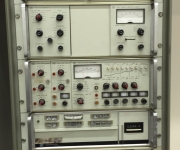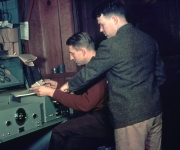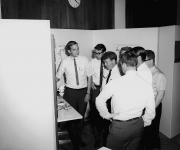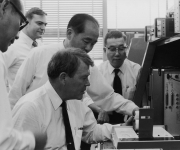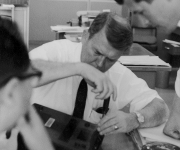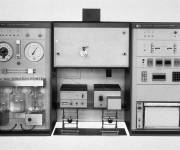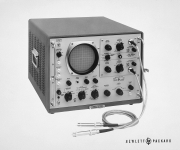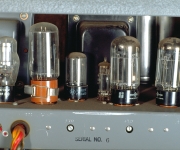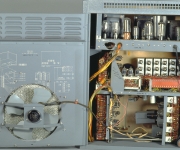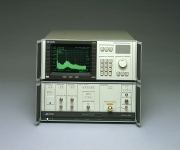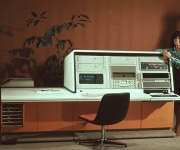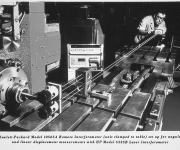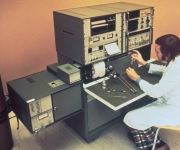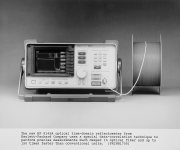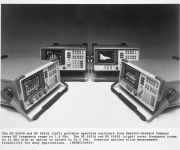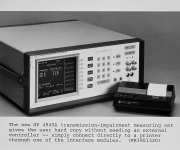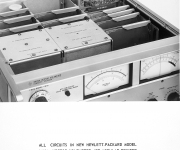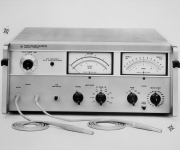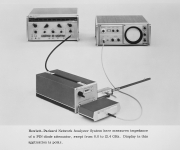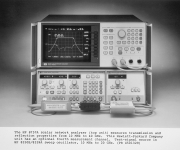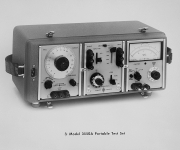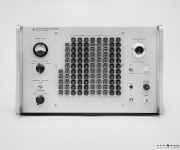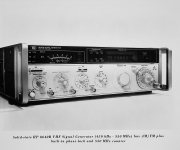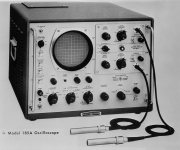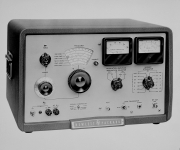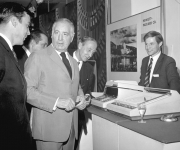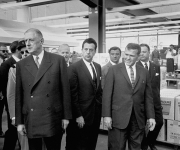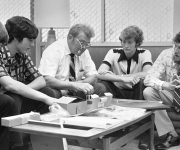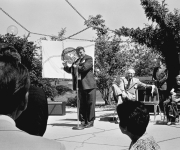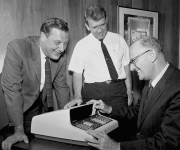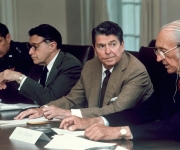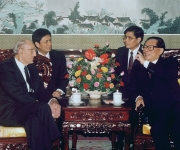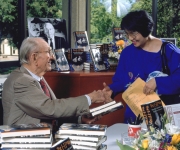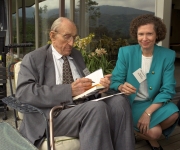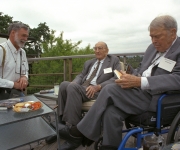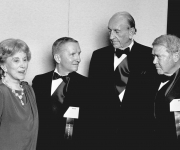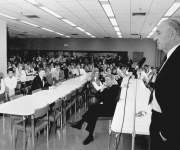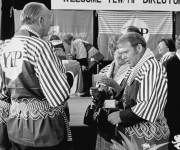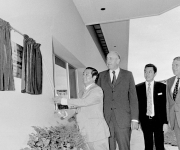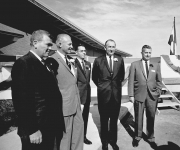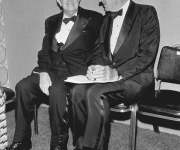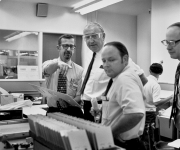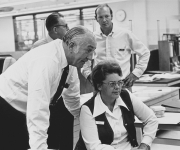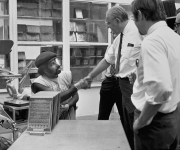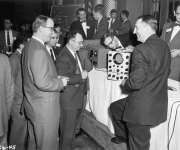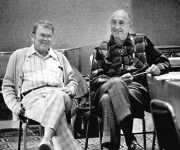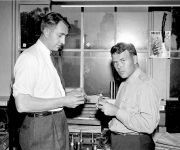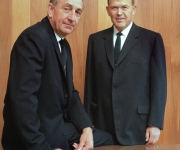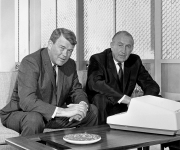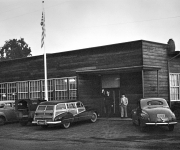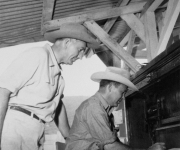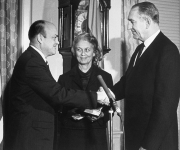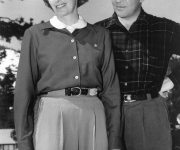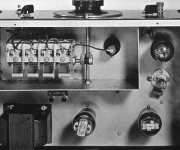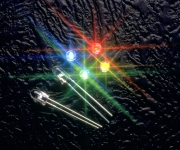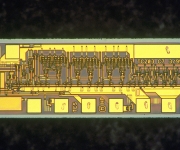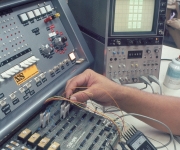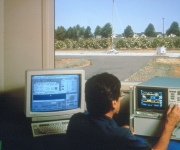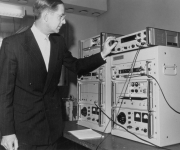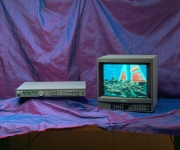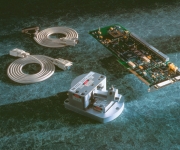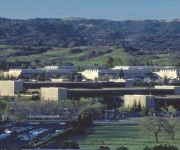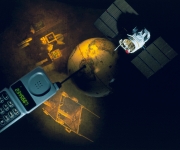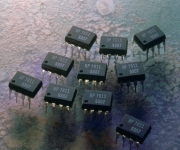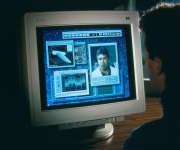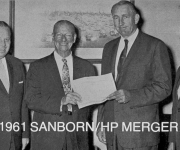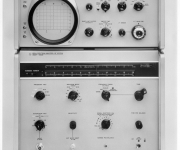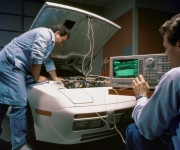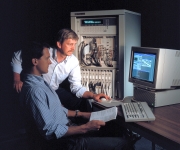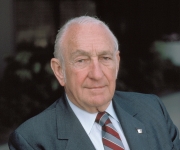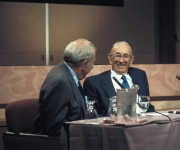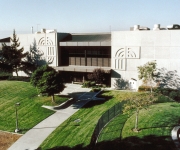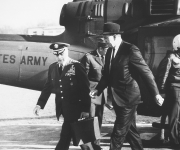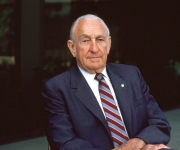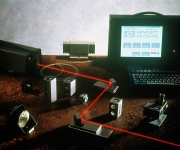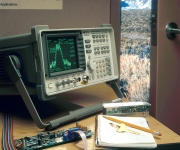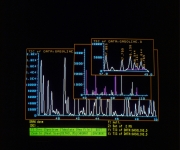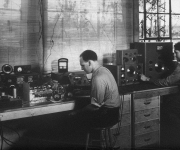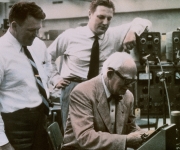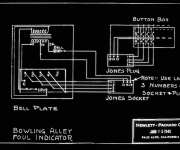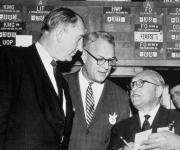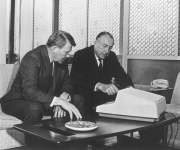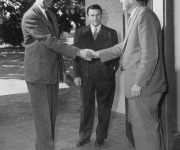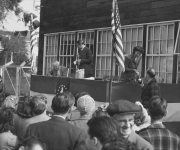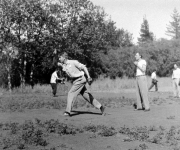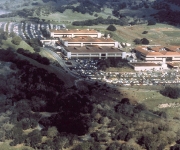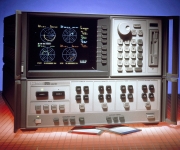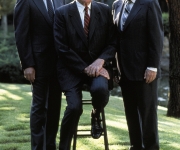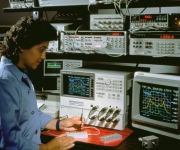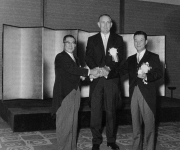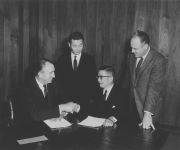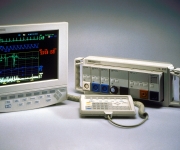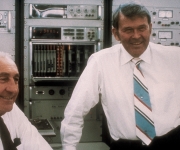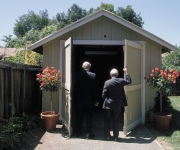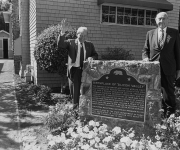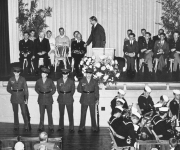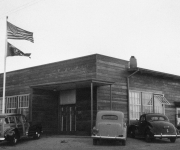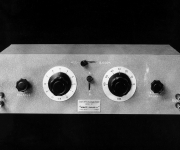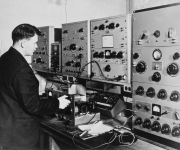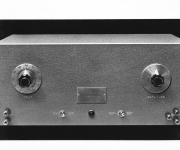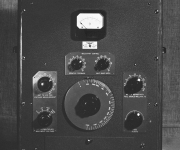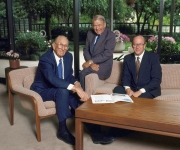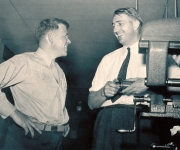Box 1, Folder 51 – Department of Defense
January 10, 1970, Launching of Bluefish, Electric Boat Co., Groton CN
1/10/70, Typewritten text of Packard’s speech.
Packard says he is “honored to play a part in the launching of this fine ship.” But he adds that “I am here only because of the function Mrs. Packard performs today in her role as sponsor…”
Packard reflects on the significance of the launching by noting that “today precedes by just seven days the anniversary of that winter morning in 1955, here at the Electric Boat Division of General Dynamics, when Commander Eugene Wilkinson ordered the crew of the NAUTILUS to cast off her lines. As most of you know, Rear Admiral – soon to be Vice Admiral – Wilkinson is here with us today, and I offer my personal congratulations to him for the important contributions he has made over the years to the nuclear power program.”
Packard also pays tribute to Vice Admiral Hyman G. Rickover – “the man who played the key role in the development of nuclear propulsion technology.” [Rickover was not present, Packard notes]
Referring to Rickover’s “pioneering work”, Packard says that “it takes extraordinary effort and dedication to transform vision into reality. Prior to NAUTILUS, there was no true submarine. Our early submarines using batteries and diesel engines were required to come to the surface frequently to charge their batteries and obtain oxygen for their crews….Only by harnessing the atom was man able to achieve the first true submersible, a ship that was at home under the water rather than on its surface.”
Packard mentions some of the achievements of the early nuclear boats: “On her shakedown cruise in 1955, in only 84 hours NAUTILUS traveled submerged more than 1300 miles – a distance greater by a factor of ten than previously traveled by a continuously submerged submarine.
“In August 1958, NAUTILUS …crossed from the Pacific to the Atlantic under the North Pole during a four-day, 1800 mile voyage. In that same month SKATE reached the North Pole and in the following year pushed her way through the ice to surface at the geographic North Pole.
“In 1960, TRITON, following the route taken by Magellan over 400 years earlier, went completely around the world in 83 days and traveled 36,000 miles without surfacing.”
“But in sharp contrast even with this impressive durability, the nuclear fuel installed in the BLUEFISH will provide power for about 400,000 miles of travel while costing slightly less than the NAUTILUS fuel.”
“The advent of nuclear submarines made possible the development of one of our most important strategic weapons. Even while the NAUTILUS was still undergoing operational testing, the Navy began development of the sea-based ballistic missile…. The POLARIS projects a new dimension of sea power, and the 41 POLARIS Fleet Ballistic missile submarines we now have in operation constitute a vital pillar of this nation’s security.”
“Nuclear propulsion has not been limited to submarines. The Navy presently has one nuclear powered aircraft carrier, a nuclear powered cruiser and two nuclear powered guided missile frigates. Today we are building the USS NIMITZ, our second nuclear powered aircraft carrier. We are also building two new nuclear frigates, the keel for the first of which, the CALIFORNIA, will be laid down later this month These ships provide the foundation of a nuclear powered surface Navy that can go anywhere in the world at instant notice.
“Why do we build such ships? As Secretary of Defense Laird has recently stated, we build them to keep the peace.
“If history teaches anything, it is surely that weakness invites attack. Our military power is our peace insurance. But military power is not enough: it must by backed up by an unshakable national resolve to defend our vital interests throughout the world.
“The Soviet Union understands seapower and she is mounting a formidable challenge to our ability to control the seas in wartime. It is clear that sea power will continue to be an indispensable instrument of our national policies and those of the Free World alliance, and that is why we continue to build those ships necessary to maintain a Navy equal to any challenge we may face.”
Returning to the BLUEFISH Packard says “She incorporates thousands of technical advances developed by our scientists and engineers over the last decade and a half. She represents one of the most sophisticated and complex weapon systems that can be built today.”
“All of you here at Electric Boat can take pride in this ship – a symbol of the finest effort of American industry and labor.
“I am enormously proud of the men and women who serve in uniform of our country. I am told that there are representatives of 38 nuclear submarines here today, and it is fitting that their wives are here as well, since they too share the sacrifices inherent in military service.
“Finally, we have that small group of men who will one day take BLUEFISH to sea. It is their judgment and skill which will make BLUEFISH an effective, fighting ship – a proud addition to the Navy. On behalf of your country I wish you and BLUEFISH success – and smooth sailing.”
1/10/70, Typewritten address from President Nixon apparently read by someone at the launching ceremony.
1/7/70, Copy of a telegram from Vice Admiral Rickover to Mrs. Packard congratulating her for being a sponsor of the BLUEFISH.
Undated, Copy of suggested guest list for the ceremony.
Box 1, Folder 52 – Department of Defense
February 13, 1970, American Management Association, Gantt Medal Award, Chicago IL
Mr. Packard spoke at this luncheon after receiving the 1969 Henry Laurence Gantt Memorial Medal which is given annually by the American Management Association and the American Society of Mechanical Engineers. The Medal is awarded for “distinguished achievement in management as a service to the community.” The recipients are “leaders who have demonstrated a profound understanding of management as something beyond the pursuit of profits for an organization or self-aggrandizement for an individual.”
2/13/70, Typewritten copy of speech by Packard with some of his handwritten notations.
Packard says he is grateful for this award, but he is not sure whether it is in recognition of his work in the private sector, or for his present activities as Deputy Secretary of Defense. He notes “with some dismay” that 1969, the year he was away, was the best year Hewlett-Packard Company has had. And as for his governmental assignment, Packard concludes “that members of the Board are not regular readers of certain daily newspapers. If they did, their decision would certainly have been otherwise.”
Packard says he plans “to wear this medal whenever I testify before congressional committees.”
Packard talks about the differences between management in private industry and in the Defense Department – “sheer size…4.6 million people, military and civilian. ..assets of $200 billion. The Department annually engages in more than 200,000 procurement actions of $10,000 or more involving more than 100,000 prime and sub-contractors. It manages installations and facilities, equipment and manpower in all 50 states and in more than 100 foreign countries.”
“A second difference between management in the Department of Defense and in a private enterprise is in evaluating results. We have no profit and loss statement to work against. The weapons we build for the defense of our country serve the country best if they never have to be used. This is most emphatically true of our nuclear weapons.
“The performance of the Department of Defense can be measured only by the extent to which the Department contributes to the overall interest of the nation. All management decisions in the Department must be measured against this all-important criterion.
“Since so much of the business of defense is preparation to avert possible future calamity, only after many years will we be able to determine with complete assurance whether we are doing the right things in the right amount and in the right way today.”
Packard cites “two additional factors that make Defense management a difficult — indeed, a hazardous – occupation.
“The first factor is the opposition to things military on the part of an articulate body of public opinion. When a large number of people view an enterprise with suspicion or hostility, the problem of giving effective management to that enterprise is compounded.”
“The second factor that currently adds to the difficulty of managing the Defense Department is the fact that the Department is no longer a growth industry. On the contrary, it is now in the throes of rather rapid shrinkage.”
Packard cites reductions in expenditures and manpower in FY 70 and planned for FY 71.
“While these special management problems are inherent in the Department, and are not likely to change, we have taken a number of steps during the past year which I believe are in the direction of much needed improvement.
“Three important steps are directed toward making better decisions on the size and character of military forces which are needed to support the national interest. These are the key decisions which must be made before questions relating to the kinds and numbers of weapons to be developed and procured can be addressed.
“Fist, the National Security Council machinery has been revitalized to evaluate more carefully what the worldwide commitments of the United States should be, and what military force levels are necessary to support those commitments.
“Second, a new arm of the National Security Council has been established called the Defense Program Review Committee to address questions of defense policy at the level of specific military programs. The PackardRC has the task of considering major defense matters, not only from a military standpoint, but also from a broader viewpoint. In particular, this group addresses defense matters in relation to the non-defense priorities of the nation and recommends resource allocation between defense and non-defense programs.
“Third, we have made changes in procedures within the Department of Defense for developing budgets, five-year plans, and programs. The changes, which provide for more effective participation by the Joint Chiefs and the military services, are producing more realistic planning and budgeting and better teamwork among the services.”
Packard then turns to a problem they have been addressing – “the question of how to improve the management of the development and procurement of specific weapons and equipment. With the great furor this last year about cost growth and cost overruns, it should come as no surprise that we in the Defense Department are also concerned.
“As one examines programs which are in trouble – and we find lots of examples – there are some conclusions that can be drawn about the origins of the problems.
“It is clear that the problems of developing new and complex weapons and equipment have, in nearly every case, been under-estimated with the result that early estimates of both cost and time required for development proved faulty.
“Too much emphasis has been placed on meeting rigid time schedules with the result that production was undertaken too often before development was finished. The short cut of rushing into production before resolving the problems encountered in research and development has been costly.
“Altogether, too little attention has been given to controlling cost.
“Program managers have been rotated out of their jobs before they became fully effective to be replaced by new managers without prior experience with their programs.
“Authority and responsibility have been diffused among many offices and individuals so that decision making has been retarded.”
Packard then describes “one fundamental change in management concepts that is gradually being introduced in the Defense Department which I think will lead to improvement across-the-board -–the concept of selective decentralization.
“We believe that more decentralization will improve management efficiency. This involves reducing the number of layers of management, and a more precise definition of the responsibility and authority of various offices in the OSD and in the Services.”
“When Secretary Laird and I assumed office, it seemed that too many decisions had to be made at the top and that too detailed a supervision of operation was carried on in the Office of Secretary of Defense. We are shifting to the military services more decision making authority.”
“Increased authority at lower levels requires increased responsibility for results.
“This means more emphasis on people and so I cannot conclude a discussion of management of the Defense Department without a word about people, who, as you know, are far more important to successful management than procedures.
“We are seeking to open up channels through which bright ideas down the line can be brought to the attention of those at the top. We are seeking to broaden the flow of information on Defense policy throughout the Department. And we are doing our utmost to assure that no barriers exist to the upward movement of talented people – particularly barriers based on race or creed or national origin.”
“Successful management of the Department of Defense depends to an important degree on the quality of management in the private industry of our nation. This is true for a number of reasons. Those who come to us to fill managerial positions often have had experience and training in private industry. Further, we must look to industry to produce the equipment and the arms with which our armed forces defend our nation.
“At the present time the Department of Defense is taking advantage of the managerial talent of the private sector in the study of its organization and operation that has been undertaken by the Blue Ribbon Commission chaired by Gilbert Fitzhugh, Chief Executive Officer of the Metropolitan Life Insurance Company. The report of this Commission, expected in mid-1970 after its year long study, should result in greater efficiency and effectiveness in the use of the resources committed to defense.”
“I accept this medal, established in memory of a great pioneer of good management, Henry Laurence Gantt, with a commitment to do my best to apply those principles to the job of making sure this country receives maximum value for every dollar spent on defenses.”
12/13/70, AMA Program for the Conference and Gantt Award
2/13/70, Press release issued by the DoD Public Affairs office containing the complete text of Packard’s speech.
2/13/70, Copy of the program for the award event.
12/2/69, Letter to Packard from Theodore T. Miller, Chairman Gantt Medal Board of Award acknowledging Packard’s willingness to receive the Gantt Award.
12/10/69, Press release from AMA announcing Gantt Award.
12/16/69, Letter to Packard from Fred Lee, AMA, discussing details of the award ceremony.
12/23/69, Letter to Packard from Richard R. Deupree, saying the AMA had invited him to the Gantt Award honoring Packard, and he is sorry he will not be able to attend.
1/6/70, Copy of a letter from Packard to Lawrence A. Kimpton, Director, Standard Oil Company of Indiana expressing his appreciation that Mr. Klimpton will present him at the Gantt Award.
1/12/70, Copy of a letter from Fred E. Lee, AMA, to Lawrence A. Kimpton saying the AMA is happy to hear he will present Packard at the Gantt Award, and asking for a copy of his remarks.
1/18/70, Letter to Packard from Lawrence A. Kimpton saying it will be a pleasure to present Packard at the Gantt Award.
1/21/70, Letter to Packard from Fred E. Lee asking for Packard’s travel plans.
1/12/70, Copy of letter to Packard from John McClane AMA, asking for a copy of Packard’s speech if prepared.
1/13/70, Letter to Packard from Professor Paul E. Holden, Stanford, who says he received the Gantt Award in 1941. He regrets he will not be able to attend the presentation to Packard
1/22/70, Copy of letter to John McClane, AMA, saying Packard will not have a copy of his speech ready in advance.
12/14/71, Letter to Packard from Robert G. Butler, AMA , inviting Packard to the Gantt Award ceremony for the 1971 recipient. Packard has written “No” at the bottom.
2/12/70, Copy of a telegram to Packard from Mel Laird congratulating him on receiving the award.
Also included are several pamphlets about the AMA and the Gantt Award
Box 1, Folder 53 – Department of Defense
February 19, 1970, Consequences of the Nixon Doctrine, American Enterprise Institute, Washington D. C.
2/19/70, Typewritten text of speech by Packard.
Packard says it is a pleasure to join the American Enterprise Institute at their annual banquet. He recognizes the contribution the AEI has made “to the improvement of communication and the elevation of the level of debate about public policy issues.”
Packard continues saying “One of the things I have learned in the course of approximately one year in public office is the difficulty of effective communication between government and the public. In every controversy in which the Department of Defense has been involved during the past year…we have had great difficulty in obtaining public understanding of the real issues. And a useful dialog on public policy is not possible without such understanding. I am aware also that there are some who permit their emotions to take charge in their consideration of certain issues and who do not want to understand.”
“So I am grateful for the help that an organization like AEI provides in offering objective analysis of policy alternatives. The clarification of issues is a great service to the strengthening of the political process by which the American people have chosen to govern themselves.”
Packard says there are many things he could talk about –“fires to put out – problems with new weapons procurement – problems with new weapons procurement – cost growth and – yes, cost overruns – to mention a few of the things that currently absorb my time and attention.
“This evening, however, I want to explore some aspects of the significant and profound change in the nation’s foreign and defense policy now in process of implementation.”
The new policy was announced by President Nixon during a TV address to the nation, and Packard lists the primary points:
“First, the United States will keep all of its treaty commitments.
“Second, we shall provide a shield if a nuclear power threatens the freedom of a nation allied with us or of a nation whose survival we consider vital to our security.
“Third, in cases involving other types of aggression, we shall furnish military aid and economic assistance when requested in accordance with our treaty commitments. But we shall look to the nation directly threatened to assume the primary responsibility of providing the manpower for its defense.”
“The Nixon Doctrine is a new policy for the United States, better attuned both to international reality and to the mood of the American people in the 1970s.
“Within our country a feeling had spread that the United States had become the world’s policeman and thereby had overcommitted itself. The long conflict in Vietnam with no end in sight and the growing strains of critical domestic problems had resulted in widespread disillusionment which focused on our foreign policy.
“The people of other nations which looked to us for protection had developed a kind of love-hate relationship toward us. Even while expecting continued support and defense from the United States, such nations became restive under what seemed to them excessive American tutelage, and, in some of them, anti-Americanism in varying degrees became part of their standard political rhetoric.”
Packard does say that “It should not be overlooked that these facts on international life, although they suggested the need for a new policy for the 1970s, do indicate that past policy was appropriate in the period in which it was developed. In most respects it achieved its objectives of providing effective security and fostering development for our friends and allies.”
“One of the dangers that faced the nation last year – and it is a continuing danger – is the possibility of overreaction against policies that were no longer appropriate. The swing of the pendulum from a policy that had become too paternalistic, both for the American people and for other nations, could very easily be so strong as to take us to the opposite extreme of isolationism and rejection of any international responsibility.
“The Nixon Doctrine avoids both extremes. It reaffirms our international responsibility and serves notice that we will not be a drop-out from the world community. At the same time it makes clear that we will not be the world policeman or the world fire brigade.
“The essence of the Nixon Doctrine is that the responsibility for international security should be shared. While the United States will continue to bear an important part of the burden, other nations will be expected to assume a greater responsibility in providing for their own defense.”
Packard says that “In Vietnam the first application of the Nixon doctrine is taking place. There, in an orderly way, the responsibility for combat is being transferred to the Armed Forces of Vietnam, and American troop strength and involvement in the conflict are being reduced.”
“A basic consequence of the Nixon Doctrine is reflected in the larger slice of the budget devoted to domestic needs and the smaller slice to defense. In fiscal year 1971, for the first time in 20 years the share of the federal budget devoted to human resources will exceed that allotted to military purposes.”
“This does not reflect any downgrading of defense.
“The protection of the nation is our first responsibility, and we must always maintain the strength required for this task
“Keeping this responsibility in mind, we are making cuts of some magnitude in the Defense budget. In current dollars, the Department’s expenditure in fiscal year 1971 is estimated at $6.9 billion less than in fiscal year 1969. In real terms, however, the reduction is almost twice this amount – a whopping $12.8 billion. This is the true measure of the program reduction that is being accomplished.”
Packard points out that these figures “portend some very important implications for the economy of the nation….There will …be important reorientation of resources.
“The curtailment of the claims on the nation’s resources for defense means a drastic shrinkage in the demand for manpower both for the armed forces and for employment in defense industry. We estimate that more than one million fewer men will be employed directly by the Defense Department or by private industry in defense-related production by June 30, 1971 than were on June 30, 1969. This should bring an easing of tight labor markets and of one source of the inflationary pressures that have troubled the economy.”
“On the other hand, Packard points out that “Over the longer time this transition of resources from defense to human needs poses problems which will impact on the entire economy of the country. The problems of transferring scientists and engineers from defense problems to human problems is not easy….Unless other opportunities for employment become available, we must recognize the obvious fact that as total jobs in the industry are reduced, national unemployment could rise and the brunt could fall on those who are just beginning to make some progress toward their rightful aspirations.”
Packard says that in formulating their budget recommendations, Secretary Laird and he have been mindful of the “dangers of cutting too abruptly and too deeply….We believe that any reduction in the Defense budget beyond that submitted to congress would run serious risks of the kind I have described.”
Packard moves on to a discussion of the implications the Nixon Doctrine will have regarding the “long standing policy of assistance to friendly foreign nations.
“If our friends and allies are to assume an expanded role in defending themselves, certain steps must be taken to improve their military capabilities. Since many of these nations are still economically less developed countries, they are unable to stretch their won financial resources to acquire the military equipment, supplies, and services which they need immediately….”…there is a real need to get ahead quickly with the task of replacing obsolescent equipment.”
Since these countries will not be able to pay out the large funds required immediately, Packard says “…the Foreign Military Sales Act, and particularly its provisions for credit and credit guarantees for the lesser developed countries, will become an increasingly important tool for the furtherance of our common foreign policy objectives.”
Packard also says the Military Assistance Program can be considered to assist those countries where “cash and credit sales will not suffice to meet essential needs.”
“Yesterday, in his message to the Congress entitles United States Foreign Policy for the 1970s, President Nixon spoke of the three cornerstones of a foreign policy that seeks to restore and maintain peace – partnership, strength, and willingness to negotiate.
“ I have chosen tonight to speak about the first of these, the concept of partnership as the President is implementing it.
“But these three principles are indivisible. Our foreign policy must be guided by all three if it is to make progress toward the goal of peace.
“The new road to peace on which we have begun will be long and arduous. We have embarked on a course of policy which the President declared is “an adventure realized not in the exhilaration of a single moment, but in the lasting rewards of patient, detailed and specific efforts – a step at a time.”
“We are far from the end of this road to peace, but we have taken our first steps.”
2/19/70, Copy of press release from the DOD with the complete text of Packard’s speech.
Box 1, Folder 54 – Department of Defense
February 26, 1970, University of Rochester College of Business Administration
2/26/70, Copy of typewritten text of speech by Packard. This speech is very similar to that which Packard gave to the American Management Association on the occasion of his receiving the Gantt Medal. Also included in this file is an outline of his remarks at the University of Rochester. The following first gives a digest of from the text of the speech at the AMA, and then notes from his handwritten notes. It would appear he used both in his address at the U. of R.
From the AMA address text:
Packard says that the job of managing the Department of Defense “includes all aspects of management that are involved in any enterprise”… but he cites a few differences:
The first being size. “The Department currently employs 4.6 million people, military and civilian – almost as many as the 30 largest industrial companies. It is spending $77 billion dollars in the current fiscal year. Its assets run in the neighborhood of $200 billion, more than the combined assets of the 75 largest companies. In the private sector of the economy, more than two million workers are employed to fill defense orders. The Department annually engages in more than 200,00 procurement actions of $10,000 or more involving more than 100,000 prime and sub-contractors. It manages installations and facilities, equipment and manpower in all 50 states and in more than 100 foreign countries.”
“A second difference between management in the Department of Defense and in a private enterprise is in evaluating results. We have no profit and loss statement to work against. The weapons we build for the defense of our country serve the country best if they never have to be used. This is most emphatically true of our nuclear weapons.
“The performance of the Department of Defense can be measured only by the extent to which the Department contributes to the overall interest of the nation. All management decisions in the Department must be measured against this all-important criterion.
“Since so much of the business of defense is preparation to avert possible future calamity, only after many years will we be able to determine with complete assurance whether we are doing the right things in the right amount and in the right way today.”
Packard adds that there are “…two additional factors make Defense management a difficult – indeed, a hazardous – occupation.
The first factor is the opposition to things m8litary on the part of an articulate body of public opinion. When a large number of people view an enterprise with suspicion or hostility, the problem of giving effective management to that enterprise is compounded.”
Packard makes it clear he is not complaining about close scrutiny by Congress , the press, or the public, all of which he agrees are quite proper and necessary. “If it is responsible, it is wholesome and can be a spur to more efficient operation. When, however, surveillance is exercised in a way that needlessly erodes morale, it does not contribute to good management.”
“The second factor that currently adds to the difficulty of managing the Defense Department is the fact that the Department is no longer a growth industry. On the contrary, it is now in the throes of rather rapid shrinkage.”
“In the period from last June 30 through the next fiscal year, the military forces will have been reduced by 551,000 men and the civilian work force, by 130,000. Expenditures in FY 69 were $78.7 billion,…and we will spend less than $72 billion in FY 71.”
Packard says that while these special problems are not likely to change, they have implemented a number of steps over the past year toward improvement.
“Three important steps are directed toward making better decisions on the size and character of military forces which are needed to support the national interest. These are the key decisions which must be made before questions relating to the kinds and numbers of weapons to be developed and procured can be addressed.
“First, the National Security Council machinery has been revitalized to evaluate more carefully what the worldwide commitments of the United States should be, and what military force levels are necessary to support those commitments.”
Packard says the National Security Council has made a comprehensive study of the nation’s needs, and “On the basis of that study, Defense needs have been allotted their place in a scheme of national priorities.”
“Second, a new arm of the National Security council has been established called the Defense program Review committee to address questions of Defense Policy at the level of specific military programs.”
“Third, we have made changes in procedures within the Department of Defense for developing budgets, five-year plans, and programs.”
“We have also been addressing the question of how to improve the management of the development and procurement of specific weapons and equipment. With the great furor this last year about cost growth and cost overruns, it should come as no surprise that we in the Defense Department are also concerned.”
“As one examines programs which are in trouble – and we find lots of examples – there are some conclusions that can be drawn about the origins of the problems.
“It is clear that the problems of developing new and complex weapons and equipment have, in nearly every case, been under-estimated with the result that early estimates of both cost and time required for development proved faulty.
“Too much emphasis has been placed on meeting rigid time schedules with the result that production was undertaken too often before development was finished. The short cut of rushing into production before resolving the problems encountered in research and development has been costly.
“Altogether, too little attention has been given to controlling cost.
“Program managers have been rotated out of their jobs before they became fully effective to be replaced by new managers without prior experience with their programs.”
“Authority and responsibility have been diffused among many offices and individuals so that decision making has been retarded.
“Changes in funding from year to year have required expensive modifications of programs.
“These deficiencies all have contributed to the well-publicized problem of cost growth for military equipment. In addition to these deficiencies, inflation has been an important contributing cause.”
Saying that he while he will not try to detail the changes introduced to secure more realistic cost estimates and better monitoring of progress through development and production, he mentions one fundamental change in management concepts that is being introduced:
“We believe that more decentralization will improve management efficiency. This involves reducing the number of layers of management, and a more precise definition of the responsibility and authority of various offices in the OSD and in the Services. Action to do this has been started during the past year, and again, we intend to proceed further during the FY 71 budget period.
“When Secretary Laird and I assumed office, it seemed that too many decisions had to be made at the top and that too detailed a supervision of operation was carried on in the Office of Secretary of Defense. We are shifting to the military services more decision making authority.”
Saying that these measures to decentralize the decision making process will put more emphasis on people, Packard talks about the importance of people.
“We are seeking to open up channels through which bright ideas down the line can be brought to the attention of those at the top. We are seeking to broaden the flow of information on Defense policy throughout the Department. And we are doing our utmost to assure that no barriers exist to the upward movement of talented people – particularly barriers based on race or creed or national origin.
“We want every person in the Defense Department to be proud of his organization and to feel tat he is an important person doing a vital job.”
Another point Packard emphasizes is that “Successful management of the Department of Defense depends to an important degree on the quality of management in the private industry of our nation. This is true for a number of reasons. Those who come to us to fill managerial positions often have had experience and training in private industry. Further, we must look to industry to produce the equipment and the arms with which our armed forces defend our nation.”
From Packard’s handwritten notes titled U. of R. College of Business Administration
“Interesting experience [Referring to his time with the Department of Defense.]
“Basic principles same [DOD and private industry]
[Management] Done through people”
“Some differences
[DOD] Complex organization
Services – dual reporting
The complexity of the organization makes problems – as does size.
“Role of System Analyst
Performed a very important function in:
More objective evaluation of programs
Overall deployment of assets into balanced force structure.
“Services have developed capability and they should evaluate their own programs.
“Too much of a decision making function instead of an aid to decision making.
“Those who are responsible for implementing a decision should have part in making it.
“If people don’t accept decision they can find effective ways of thwarting it.
“There are judgments from experience and other factors that must be taken into account.
2/26/70, Program for Packard’s speech at University of Rochester, Guest Lecturer Series
Box Listing
Box 1, Stanford……………………….1957–1961; Folders 1/1–1/8
HP Management………………1957–1994; Folders 1/9–1/35
Department of Defense……….1969–1970; Folders 1/36-1/54
Box 2, Department of Defense………1970–1972; Folders 2/1-2/25
General Speeches……………..1954–1965; Folders 2/26-2/71
Box 3, General Speeches……………..1966–1974; Folders 3/1-3/49
Box 4, General Speeches……………..1975–1982; Folders 4/1-4/38
Box 5, General Speeches …………….1983–1995; Folders 5/1-5/46
Box 2, Folder 1 – Department of Defense
April 14, 1970, St. Louis Chamber of Commerce and American Ordnance Association, St. Louis, MO
4/14/70. Typewritten text of Packard’s speech with notations handwritten by Packard.
After repeating a quotation from Lincoln, Packard says “Lincoln’s words remind us that there is more to national security than military power and that serious threats to the security of a nation may arise within a society as well as from outside.
“Recognizing these truths President Nixon has been guided, not by a limited, but by a comprehensive concept of national security in designing his legislative program and the budget which he submitted to Congress in January.
“That National budget is characterized as a reversal of national priorities. Its most striking characteristic, when it is compared with the budgets of the preceding 20 years, is that it puts defense spending in second place. For the first time since our nation went to war in defense of South Korea, spending by the national government for human resource programs will exceed spending for defense purposes.”
“These are severe cuts that are being made in military spending, but these reductions are consistent with the Nixon Doctrine which looks to our friends and allies to carry a larger share of their own defense. The reductions will allow our country to spend more on non-defense activities, $25 billion more in 1971 than in 1969.
The decisions which underlie the President’s budget are the result of the most vigorous, searching, and comprehensive consideration of our national needs and resources that has ever been undertaken in Washington.”
“The group which makes the study and offers its recommendations to the President is the National Security Council. This agency is now performing the functions originally envisaged for it. The Council addresses the fundamental issues of foreign policy, clarifies our basic purposes, examines all alternatives, and recommends actions. It is the President, of course, who makes decisions.
“The major issues of defense requirements in relation to other claims on the budget are treated on systematic and integrated fashion by another group known as the
Defense Program Review committee.
“What is important to remember as that the Defense Program Review Committee and through it, the National Security Council, look to the totality of national needs and resources in making recommendations on the allocation of resources to defense purposes. They consider how much defense and what kind are needed to support United States interests around the world. They consider our domestic needs as well, weighing proposed defense expenditure against alternative uses of equal resources for meeting domestic problems. Finally, they consider what we can afford, weighing both international and domestic expenditure on the scale of the economy’s output.”
Packard says few would disagree that there are pressing domestic needs requiring greater governmental outlays: housing, education, health care, environment, crime, manpower training….
“…inflation remains a matter of serious concern, calling for restraint in total federal expenditure….
“Defense spending is being reduced so that more resources can be applied to urgent domestic problems without fueling further the fires of inflation.”
“I believe this step-up of non-defense spending can be justified in terms of national security. The first reason for making more of the good things of life available to many who cannot now attain them is that this is the right thing to do. But to reduce injustice, to end discrimination, to eliminate deprivation also dampens stride and conflict, and promotes the unity of purpose that is essential to security.
“There is little security for a nation whose people are not unified in some common purpose by a bond of mutual respect and trust. There is little security for nation if a substantial number of its people believe they are left out of its society. There is little security for a nation if a large number of its people believe that it stands for nothing worth defending.”
Packard says the Department of Defense “engages in many activities which can and do make an important contribution to the resolution of domestic problems.
“As an example, the Department of Defense for some time has stressed the principle of equal opportunity. Within the military forces it has gone a long way toward attaining this goal. It has labored with considerable success to open up housing accommodations in the neighborhood of military installations to all who wear the uniform. It has required private contractors with whom it hoes business to meet the full requirements of the law in offering equal opportunity in employment.”
“There are many more things we do. We provide our young people in uniform extensive education and training which greatly improves the ability of many to achieve success in their future lives as civilians.
“We have many bases and facilities – and people – involved in effective summer programs for underprivileged children.
“We stand ready to assist states, cities, and local communities in the cases of disaster.
“I want to ,make it clear that merely spending more on domestic problems and less on defense is not a panacea for domestic strife. Yet, it can help as part of a coordinated program that goes to the causes of the conflicts which trouble the nation The new direction in which the President’s budget points is one in which the nation should move – always exercising care to avoid dangers of excessive reduction of our defense capability. “
With plans underway to reduce defense forces by more than 600,000 Packard acknowledges that some might ask “whether our security from outside threats will be adequately protected….
“It is true that we do not yet perceive any substantial abatement of the trouble and strife around the world that led the nation to build up its armed forces to the levels they had reached when President Nixon took office.
“The cuts that are being made in our armed forces are made possible, not because threats to peace have lessened, but because we expect other nations to assume more of the responsibility which we have been carrying for their defense.”
“This process is now in operation in Vietnam where 115,000 American troops have been replaced by South Vietnamese.”
“There is one area in which we cannot afford to lower our forces. We must maintain a credible deterrent against nuclear war. Hat is why we are asking congressional approval to proceed further toward the development and deployment of the SAFEGUARD antiballistic missile system.
“We hope that a meaningful agreement on strategic arms limitation will be reached by the representatives of our country and of the Soviet Union. It would be a mistake, however, to base our program on the assumption that an agreement will be reached.
“Our security in every sense inextricably linked to a healthy economy. Without the vast productive capacity of our economy, without its dramatic technological progress, without the brain power and skill of management and labor, we would have neither the weapons that provide security from threats from without nor the material well-being that helps to give security from threats within.
“There are some who say we must neglect our needs at home in order to discharge our international responsibilities. Others say we must return to isolationism in order to give adequate attention to domestic problems. President Nixon rejects both of these extremes.
“Last June, the President expressed his views to the graduates of the Air force Academy. He said”
“A nation needs many qualities, but it needs faith and confidence above all. Skeptics do not build societies; the idealists are the builders. Only societies that believe in themselves can rise to their challenges. Let us not, then, pose a false choice between meeting our responsibilities abroad and meeting the needs of our people at home. We shall meet both or we shall meet neither.”
4/14/70, Copy of Press release issued by DOD Public Affairs office providing complete text of Packard’s speech in St. Louis.
Box 2, Folder 2 – Department of Defense
April 24, 1970, Thomas Jefferson Awards Banquet, Washington D. C.
This was a banquet to honor the men and women in the Armed Forces news organization.
4/24/70, Typewritten text of Packard’s speech.
Packard says it is “a pleasure to be here with Lowell Thomas, Herb Klein, Dan Henkin, general Westmoreland and the top professionals of America’s new business….”
Packard talks about his experience with communications in the Hewlett-Packard Company. He says they didn’t have much need to communicate with the public at large, but “I quickly came to the conclusion that a company newspaper increased greatly the effectiveness of a business organization. It was an essential means of communication with the employees.” He adds that he “has had an opportunity to look over the winning entries and it is clear that the unit, base, and shipboard papers and publications serve a similar vital functions with our Service people worldwide.”
“Americans want to know what is going on and this desire stays with them when they become members of the Armed forces. So it is a responsibility of the Department of Defense – though perhaps one of our less well known responsibilities – to assure that our soldiers, sailors, airmen and marines continue to get the news – continue to be well informed – regardless of where they happen to be stationed.”
“To achieve this,” Packard says, “we publish more than 1900 newspapers and maintain more than 400 military radio and television stations throughout the world. The source of most of the national and international news transmitted over these networks is the civilian news media – the AP and UPI, the other syndicates and the national networks.”
“When Secretary Laird took office 15 months ago, he set as a major and primary objective establishing the credibility of the Department of Defense. This policy requires that maximum information be made available to the men and women in uniform as well as to the civilian population. The news and information which come through military news channels must be straightforward and factual, and neither tinted nor slanted.”
Packard singles out for special commendation “those who edit and staff the newspapers which serve many of our bases and major tactical units. They are the unsung heroes of the military news business. These newspapers – many published on mimeograph machines – are the military version of the small daily and the home town weekly. They provide the serviceman with the “news he can use”.
“These news papers keep the serviceman up to date on what is happening in his own back yard, and provide him with timely information important to his personal advancement and welfare. He looks to them for news about his friends and his outfit, and for information pertaining to his assignments, his promotions, his pay and allowances. It is the one newspaper in which he has a better than even chance of seeing his own name in print. This is the newspaper that he sends home to his family and friends.
“These military newspapers play a vital role in maintaining the morale of our military forces, and I am indeed pleased that they are being given special recognition here tonight, along with their more glamorous relatives, the military magazines and radio and television stations.”
Packard expresses his “appreciation and the gratitude of the entire Defense Department to the publishers of Time, Newsweek, and the Readers’ digest, for their sponsorship of the awards being given here tonight. I also thank the eminent representatives of the fourth Estate who have gives so freely of their valuable time to participate in the Symposium the Defense Department is proud to be associated with them in this endeavor.
“The Thomas Jefferson Symposium testifies to the desire and determination of the Department of Defense that servicemen be well informed, for it provides unexcelled training for more than 400 of our information specialists from all the services and from all parts of the world. We depend on these able, enthusiastic, and dedicated men and women to keep our armed forces informed about the events of the times, their heritage as American citizens, and their role in national defense.
“Through this Symposium, they have met, learned from, and, I am sure, been inspired by this group of top professional men from American journalism – a group which includes the co-dean of the Pentagon news corps, Mr. Charles Corddry of the Baltimore Sun.
“The Department is indeed proud to sponsor this Seminar. I am sure that our military information specialists have been enriched by this experience and that they will go back to their assignments with renewed confidence and inspiration. Some, I know, will return here next year to receive one of the Thomas Jefferson awards.
“On behalf of Secretary Laird and myself, I want to congratulate all of you young men and women who took part in this symposium. We recognize the tremendous importance of your work, and we are proud of the manner in which you are doing it.
“Thank you very much.”
Box 2, Folder 3 – Department of Defense
April 30, 1970, Crozier Award, American Ordnance Association Washington
4/30/70, Copy of the press release issued by the Public Affairs office which provides the complete text of Packard’s speech. Attached to the press release is a note by Packard’s secretary, Margaret Paull, saying “Col. Furlong did not bring back the original of this speech after the dinner presentation.”
Packard says he accepts the Crozier on behalf of the people he represents – “the military and civilian employees of the Department of Defense. These are the men and women who keep our armaments ready and thereby contribute to the maintenance of peace.”
Packard gives some background on Major General Crozier who was Chief of Ordnance of the United States Army for17 years – from 1901 to 1918.
“Because of the responsibility he bore for arming American forces during the initial period of our nation’s participation in the First World War, General Crozier was aware of the heavy costs of unpreparedness.”
Packard tells how when WW I began our armed forces were about the size of Sweden’s. During the war we had to rely on our allies for tanks, artillery, and airplanes. “Of 23,000 tanks on order in the United States, only 76 had been completed at the time of the Armistice.”
In WW II we were unprepared again. “As late as 1938, we were spending no more, to acquire armored vehicles than for horses, wagons, saddles, and harnesses.”
“World War II was followed by another period of neglect of our armed forces. When war broke out in Korea, again the nation was unready.”
“I is no exaggeration to say that our nation has been poorly prepared for three of the four major conflicts in which it has become involved in this century. The costs of unpreparedness in lives and in treasure have been tragically high. In the past, time has been granted to us to recover from initial setbacks, to arm, and finally to win the day.
“In the nuclear world of today, we cannot count on time to be our ally. We must be prepared at all times or we will not survive.”
“There are great pressures toward a reduction of our military power in the decade of the 1970’s. The pressures come from the domestic front, both economic and political.
“We in the Department recognize the urgency of unmet domestic needs and the seriousness of the problem of inflation. To permit increased federal spending to meet these needs without further fueling the fires of inflation, the President has made significant cuts in the level of defense expenditures.
“The course we are following is a realistic course, not because of any significant lessening of the antagonism and tensions around the world, but because of the increasing ability of our friends and allies to carry a larger share of the burden of their own security. It will be a safe course if reductions are limited and carefully controlled to maintain a foundation of strength adequate and responsive to potential contingencies of the future. This foundation must include an adequate nuclear deterrent.”
“There are strong pressures, however, for reductions that go far beyond those which President Nixon has approved.
“The greatest concern that I have at the present time is that defense cutbacks will go beyond the point of prudent risk. The greatest responsibility that Secretary Laird and I have is to keep the nation on the course of orderly reduction in defense and to maintain a capability that will protect the American people in the years ahead.
“Our past experience should teach us that an inadequate level of defense spending is an illusory form of economy. In a month or two, a war eats up the savings realized over the course of many years by inadequate funding of defense. In a future war, unpreparedness would be more than costly It would be suicidal.”
“We must remember that in the past five years, the United States has stabilized deployment of strategic offensive weapons, while the Soviet Union has accelerated both their development and their deployment. Our nation has made no basic change in the force levels set in 1965-67. On the other hand, the Soviet Union continues to add to its total of strategic nuclear weapons. And, as we have recently seen, the Chinese are still on their technological track to a ballistic missile.
“As Secretary Laird and I have pointed out, it is not the strategic balance that exists today that disturbs us but the momentum established by the Soviet Union in its vigorous development deployment of strategic offensive weapons. The vigor of the Soviet effort is indicated by the fact that Russia now has more land-based ICBM’s than the United States. Nor can we forget the progress of Communist China toward an ICBM capability.
“For these reasons, the President has recommended to congress a modest addition to the SAFEGUARD Anti-Ballistic Missile program which was approved last year.”
“To forego the SAFEGUARD deployment is a gamble this country cannot afford to take.
“The course toward which President Nixon is steering the nation is in the direction of peace. His policy is one of responsible internationalism It does not contemplate a United States which will patrol the world as a global policeman nor a United States which abdicates responsibility and cowers in isolationism.
“Successful implementation of the President’s foreign policy requires a strong defense posture for our country as far into the future as any of us can see.
“The consequences of past failure to maintain such a posture are the casualties of three wars which have occurred in the lifetime of most of us here this evening.
“Let us not in the future be forced again to mourn the loss of young Americans who died because their country let its sword rusts. Let us not forget that, on our preparedness and our national resolve, depends the survival of our country.”
Box 2, Folder 4 – Department of Defense
May 12, 1970, National Association of Manufacturers, NAM Directors Luncheon,
Washington D. C.
5/12/70, Typewritten text of speech
Packard tells the audience that his remarks are “off-the-record and off-the-cuff.”
Packard describes the “major re-examination of the nations policies and priorities” which was recently undertaken. “This re-examination has resulted in what has come to be known as the Nixon Doctrine based on three principles: partnership, strength, and negotiation.”
“This has resulted in a major re-direction of federal resources from defense into non-defense programs.” Packard gives some specific examples:
1. Redirection of resources with a balanced or surplus budget to maintain fight against inflation.
2. Direct larger share of resources into non-defense programs
.
- This has placed a stringent requirement on DOD to maintain strength of military forces at lower levels of expenditure –
FY 1969 – 78.7 B
FY 1970 – 77 B
FY 1971 – 71.8 B “
“Tremendous challenge to DOD and defense industry to improve new weapons development efficiency. We can do much to build a smaller but more effective military establishment.
“One of the important objectives of this exercise is to apply more of the nation’s resources to domestic programs. The reallocation of financial resources is significant. The resulting reallocation of people will – already is – generating some serious problems.
- We are doing what we can in helping local communities.
- The federal mechanism is not effective market place.
- The skills of the aerospace industry cannot be quickly reorientated. The impact on professionals – scientists – engineers – young graduates.
- Impact on lower job levels – the underprivileged”
“We have a special responsibility to help those fine young men and women who have been serving their country in the Armed Services when they are released to the civilian job market.”
“I make a special plea to the NAM to join with business and industry throughout America to five special priority in jobs to those men and women who have served their country…particularly over those who have burned their draft cards and made disruptive attacks on the great educational institutions of America.
“We all protest the right of protest – Our country must continue to face change as it has from its beginning some 200 years ago. It is that small minority that advocates the destruction of American system by force that must be – and I am confident it will be – brought under control.
“And let me emphasize – I believe the young ;people have something to say….It is only a small minority of faculty and students who are bent on destruction – and let me repeat – that small militant minority must be brought under control.
Packard moves on to Cambodia
He explains that the North Vietnamese have refused to negotiate in Paris—and that the U. S. has instituted a policy of “Vietnamization” – gradually replacing American forces with South Vietnamese, which has been successful.
“The North Vietnamese have recognized the success of Vietnamization by changing their strategy. Their strategy is to operate harassing attacks against cities, villages hamlets and military installations. Their ability to do this is to a large extent determined by the fact that they have established large bases inside Cambodia along the border. This territory is occupied by the North Vietnamese. This occupation has been accepted by Sihanouk for the past four or five years. This has given the opportunity to the North Vietnamese to build up substantial installations and stacks of supplies in these sanctuary areas.”
“
when Lon Nol took over in Cambodia he requested the North Vietnamese to leave, and made it abundantly clear that he considered they were there in violation of the neutrality of Cambodia.
“This made it possible for us to undertake action against these bases on the first of this month. This was by far the most effective military action that could be undertaken to hasten the progress of Vietnamization.”
Packard concludes with a progress report on this operation, which he says has exceeded their expectations.
“Some 1200 tons of munitions have been discovered already and the amount is increasing every day.
“This includes thousands of weapons, millions of rounds of ammunition – 6 million rounds of 51 caliber anti-caliber ammo – used against helicopters – over 1800 tins of rice.”
“In addition, a large amount of medical supplies have been captured. One estimate is that 24,000 pounds of medical supplies will support a 320-bed division-level hospital for from 90 to 100 days ….”
Packard says that “The U. S. ground troop involvement will be complete by or before the end of June.
“We do not intend to enlarge our involvement in Southeast Asia – in fact, this action will bring closer the time when our boys will all be out of fighting I hope you will give your full support to the President in his decision – I hope when you go back to your local communities you will encourage your friends and associates to join with us all in supporting this important decision.”
5/12/70, Typewritten sheet listing the consequences of the FY 71 budget
5/12/70, Handwritten notes by Packard for speech
5/12/70, Typewritten transcription of tape made of Packard speech – incomplete.
3/31/70, Copy of letter to Packard from Edward C. Uhl Fairchild Hiller expressing appreciation that Packard willing to speak to NAM and giving details for luncheon.
Box 2, Folder 5 – Department of Defense
May 15, 1970, Armed Forces Day, Chamber of Commerce, Ft. Worth TX
5/15/70, Typewritten text of speech, with handwritten notations by Packard
Packard says Armed Forces Day is a time to reflect on the mission of the armed forces, grateful recognition of the service and sacrifice of the three and a quarter million men and women in uniform, and a time to show special regard for our service men who are striving to assure the peace in South east Asia.
He asks for special help in assisting the two million men and women who will be leaving military service over the next two years, help the 75% or so who will be looking for civilian jobs.
But Packard’s main topic is Cambodia. He goes over the reasons we are fighting there, and what the results have been.
“To gain perspective on this subject, one must understand President Nixon’s Vietnam policy, for the action in Cambodia is directed toward achievement of the objective of ending the war in Vietnam on terms which will assure freedom of choice for the people in south Vietnam. Those Americans who dissent in the name of freedom of choice should be the first to support this freedom for the South Vietnamese.
“One year ago yesterday, President Nixon offered in a speech to the nation and the world to negotiate a fair and generous peace to bring the war to an immediate end. The only point which the President insisted a peace settlement must contain is preservation of the right of the people of South Vietnam to determine their own destiny. Everything else, the President asserted, is negotiable.”
“Although we have not given up attempts to reach peace at the conference table, the failure to make progress by means of diplomacy forced the President to find an alternative route toward his objective – a route which Hanoi could not blockade by the tactic of non-cooperation.
“This route is called Vietnamization.” Packard explains that this program is gradually replacing American forces with those from South Vietnam. “By the middle of next year, we will have turned over all combat operations to the South Vietnamese forces.”
“In short we have been methodically reducing our forces in Vietnam and we plan to continue that reduction. We plan to do this in an orderly way as South Vietnam attains even greater capability to defend herself.
“What is now being done in Cambodia is not a reversal of our policy to reduce our involvement in southeast Asia There is no change in our objective. On the contrary, it is a carefully considered plan to hasten the achievement of our objective.”
Packard explains how the North Vietnamese occupied border land in Cambodia for bases and supply dumps – with the acceptance of Cambodia’s leader Prince Sihanouk. For political reasons the U.S. did not attack these sanctuaries for over five years. But as the North Vietnamese were squeezed out of South Vietnam their v]bases in Cambodia took on more importance. When Lon Nol replaced Sihanouk he ordered the North Vietnamese out of Cambodia. The U. S. felt free to attack the North Vietnamese in Cambodia ”As long as these bases remain, the war could continue indefinitely and inconclusively. As long as the bases remained, the risks were substantial as more and more American troops were pulled out of South Vietnam.”
“It is solely because of the importance of the border areas to the success of our Vietnamization plan that we are helping clean them out.
“The action we are taking has been limited by the President both in terms of territory and of time The President has set a June 30 deadline on these operations and limited penetration by American troops to areas within 30 kilometers of the border.
“Some might question the wisdom of letting the enemy know where we will fight and when we will stop. The President has done so in this instance because he wants the American people to understand that this is a temporary and limited operation and that he – more than anyone else in this country – wants the war brought to an end.
Packard describes “the massive haul” of military supplies captured in Cambodia – supplies , tanks, ammo food that cannot be used against South Vietnam.
“We hope that we shall be able to celebrate an Armed Forces Day soon in a peaceful world in which no American is involved in combat anywhere. The coming of that day is being hastened by what our military forces are doing this day with patient courage.
“Let us who are not exposed to the danger and privation they must bear show the same patience and steadfastness.”
5/15/70 – News release from DOD Public affairs office including complete text of Packard’s speech.
Box 2. Folder 6 – Department of Defense
May 28, 1970, Formulation of Defense Policy, Naval War College, Newport , RI
5/28/70, Typewritten copy of Packard’s speech, including copies of projection slides which he refers to in his address. All this material is marked “SECRET”.
“I. INTRODUCTION”
Packard says that he wants to talk about “the formulation of defense policy at the highest levels in our government. This decision-,making process is not confined to the Department of Defense; the issues involved directly concern many more. The role of the Defense Department and the other Executive Agencies concerned is advisory. The decisions are for the President and the Congress.
“ Slide 1, FORMULATION OF DEFENSE POLICY
- National Security Objectives
- Strategies
- Resources”
Speaking about the points on the first slide, Packard says that formulating defense policy is a three-fold process:
“First national security objectives are determined; next, strategies are devised to achieve these objectives; finally, resources are allocated to accomplish the objectives. Once defense policy is set, it is our job in DOD to provide the most efficient implementation of the objectives with the resources available.”
Packard tells his audience that there are two basic reasons why it is important that they understand the process for formulating defense policy: “First we in DOD cannot expect to perform our role effectively unless we understand the rationale of decisions made largely outside of the Department, determining the objectives established and budgets allotted; second, and even more important, although basic defense policy decisions are made by the President, they are made by him with the advice of his national security advisors. Thus we have a crucial role in this determination of defense policy. To make decisions on defense issues, the President must be informed, and information relating to defense comes to the President from the Secretary of Defense and the Joint Chiefs of Staff., his key advisors on defense policy. The preparation of this information is the product of many minds in DOD, and for those who are participating in this preparation now or in the future, it is essential that the issues involved in the formulation of national security policy are understood.”
“II. “THE ISSUES INVOLVED IN DETEREMINING DEFENSE POLICY”
“Slide 2, ISSUES FOR DEFENSE POLICY
Strategic
Immediate Threat to U.S.
General Purpose
Assist Allies”
“Defense policy involves two principal elements for consideration,” Packard says, “strategic forces and general purpose forces.” He says that the only immediate military threat to our national survival is the strategic nuclear forces of the Soviet Union. “It is therefore obvious that we must provide an adequate defense against this threat. The strategic issues involves are essentially the proper response to the present threat, the anticipation of future threat, and the appropriate levels of confidence in our forces. These are relatively technical issues which are primarily our concern within DOD.”
Packard explains that the utilization of general purpose forces is a more complex problem. “These forces are designed primarily to defend our interests in other parts of the world – including assistance to our allies – not to defend our own territory. To determine what level of general purpose forces we should maintain, we must carefully evaluate our national interests in various areas of the world, assess the m8litary threat to these interest, estimate the capabilities of our allies to defend themselves, and finally, determine what U.S. military forces are necessary to protect our interest.
“You might think that after making this analysis, we then simply provide enough defense funds for the forces which are determined to be necessary. Unfortunately, the problem is not so simple; one crucial consideration has yet to be mentioned – the limited national resources available. This unavo8dable reality is often difficult to understand in a country with a GNP of close to one trillion dollars and the theoretical capability of affording a much larger defense budget than it now has or has had since [World]War II. The problem is that there competing claims for these resources.
“Slide 3, RESOURCE ALLOCATION PROBLEM
Sector Competitors
Total Economy Public vs. Government
Government Federal vs. State and Local
Federal Government Defense vs. Domestic
Defense Strategic vs. Gen Purpose vs. R&D, etc.
Strategic ICBM vs. SLBM vs. Bombers, etc.”
Packard briefly mentions the fist two listed, Total Economy [government vs. funds from the private sector via taxes] and, within the Government, the competition between federal, state and local governments for public revenues.
“Finally, and most significantly, there is a great competition within the federal government, including within DOD, for these remaining, limited resources. To be sure, a greater allocation of resources to defense means greater national security. However, the size of the allocation is necessarily restricted by competing demands which are also essential for this country’s well-being. The objective is to establish a reasonable balance between the security desirable and the funds available.
“This ever present problem has been especially acute in recent years. In order to cope with it, one of the President’s first actions upon assuming office was to order a sweeping review of national defense policy in National Security Study Memorandum 3, or NSSM-3” Packard says he wants to describe the major steps in that review, “both to give you a background for the defense policy decisions which flowed from it, and to illustrate my broader theme of how defense policy is formulated. The review considered both strategic and general purpose forces, but for the reasons I have already mentioned, I will discuss only the general purpose forces section of the review.
III. THE NSSM-3 REVIEW OF GENEREAL PURPOSE FORCES
- Organization and Plan of the Study
Slide 4 NSSM-3 STUDY PARTICIPANTS
Defense Department
State Department
CIA
Treasury Department
BOB
CEA
NSC Staff
Packard notes that “National Defense Policy at the most basic levels is not the sole concern of the Department of Defense, and in accord with this reality the NSSM-3 Review was a joint effort of all government agencies directly concerned with national security.” And he refers to the list on the slide.
“Among the participating agencies, the Defense Department had a principal responsibility for most of the issues involved, and I served as Chairman of the interagency group.
Slide 5, METHODOLOGY
- Alternative Strategies
- Alternate Forces and Costs
- Five-Year Economic Projections
- Domestic Programs and Costs
“The group’s methodology was as follows:
1.We postulated a broad range of alternative national strategies.
2. For each alternative, we designed a set of military forces and estimated their annual cost.
3. For a time horizon of the next five years, we projected GNP federal revenues, uncontrollable expenditures, and the residual for controllable programs, including defense.
4. We considered sets of domestic programs, with estimated annual costs, as illustrative competitors for the controllable federal resources.
“Last summer, the study was forwarded to the National Security council for review and then to the President for decision. No recommendations were made by the study group, although the President’s advisors, including the Secretary of Defense and the Chairman of the Joint Chiefs of Staff, expressed individual recommendations. The result was a Presidential decision last fall which defined a general purpose forces strategy and set annual defense budgets for the next five years for planning purposes.
“B The Alternative Defense Policies
Packard says the first step in the NSSM-3 Review was the design of a wide range of so-called national “strategies”. However, he admits the choice of the word strategy may have been “unfortunate,” and had created some communications problems. So, he explains what they meant by the term strategy. “I know that you normally regard the development of strategy as the responsibility of the Joint Chiefs of Staff….What we meant by strategy was a broad set of national defense objectives which form the foundation of defense policy.
Slide 6, STRATEGY
President and Secretary of Defense
What is to be done
Joint Chiefs of Staff
How to do it
The establishment of such policy in the Executive Branch is the responsibility of the President and the Secretary of Defense. Of course such policy decisions are subject to the review of congress. The responsibility of the Joint Chiefs is primarily to recommend yow the forces should be employed to achieve the national objectives.”
Packard says the “NSSM-3 review initially considered nine alternative strategies, ranging from an isolationist fortress America concept to a strategy which would have provided forward deployed forces to conduct sustained conventional defenses simultaneously against the Warsaw Pact in Europe and against the Chinese in Southeast Asia and Korea.”
However, Packard explains, they soon focused on five strategies, the other four being “either infeasible or undesirable.”
Slide 7, ALTERNATIVE STRATEGIES
- NATO Initial Defense and Assistance for Allies in Asia
- NATO Initial Defense or Joint Defense in Asia (Korea or Southeast Asia)
- NATO Initial Defense and Joint Defense in Asia (Korea or Southeast Asia)
- Sustained NATO Defense and Holding Action in Asia or Initial Defense of NATO and Joint Defense of Asia (Korea and Southeast Asia)
- Total NATO Defense and Joint Defense of Asia (Korea and Southeast Asia)
Slide 8, VARIABLES IN STRATEGY
Geographic Areas
How many at the same time
Warning
Capability of Allies
Packard says “These five alternative strategies embodied four key variables:”
“1.The geographic areas for which we would consider the use of military forces.”
“2. The number of objectives we wanted to be able to meet at the same time.”
“3. Strategic warning.”
“4. Reliance we would place on capabilities of allies.”
“Slide 9, SEPARATE EVALUATIONS
State: – Foreign Reactions
CIA — Enemy Capabilities and Reactions
JCS – Military Risk”
“Each strategy was evaluated in terms of its major military risks and foreign policy implications. To this end, the State Department led a study which examined the likely impact of each strategy on our allies and on our foreign policy, and the CIA directed a group examination which estimated the capabilities of potential enemies and how they might react to the various strategies.”
“Slide 10, STRATEGY ONE
NATO Initial Defense and Assistance for Asian Allies
Major Risks – CIA and JCS
NATO: Cannot meet surprise attack following concealed mobilization
Asia: No conventional capability vs. CHICOM
JCS Comment: Inadequacy evident to all
Foreign Reactions – State Department
NATO: None, probability of Warsaw Pact aggression unchanged
Asia: Acceptable, pace reductions;
CHICOM might increase support for wars of national liberation”
“Strategy 1 would allow for forces to conduct an initial defense of NATO Europe while at the same time assisting Asia Allies against a non-Chinese attack. The major risks as assessed by the CIA and the JCS would be as follows: For NATO, allied forces would not be able to meet a surprise attack by the Warsaw Pact following concealed mobilization: for Asia, there would be no conventional capability against Communist China. The JCS contended that the overall inadequacy of the projected force structure to satisfy our defense commitments in Asia, even without a simultaneous European requirement, would be evident to all.
The State Department anticipated the foreign reactions to be essentially unchanged. For NATO, there would be no reaction from our allies since this alternative would not alter current NATO strategy in any significant way. The probability of Warsaw Pact aggression was also predicted to remain unchanged. In Asia, the strategy should be acceptable to our allies, especially if the reductions were made over a period of years. The State Department noted that Communist China might increase support for wars of national liberation.
“Slide 11, STRATEGY TWO
NATO Initial Defense OR Joint Defense in Asia
Major Risks – CIA and JCS
NATO: Cannot meet surprise attack following concealed mobilization
Delay in NATO if engaged in Asia
Coordinated Warsaw Pact CHICOM unlikely – likely
Foreign Reactions – State Department
No adverse reaction if they perceive U.S. maintain commitments”
“Strategy two dictated that the U.S. would be equipped to provide an initial defense of NATO Europe or a joint defense of Asia. (Asia being defined for these purposes as Korea or Southeast Asia). There would be a major capability in one theater and a reduced capability in the other, non-war, theater. NATO forces would again be incapable of meeting a surprise attack following concealed mobilization. Moreover, if U.S. forces were involved in Asia, there would be a corresponding delay in meeting required force deployments to Europe for initial defense. Concerning the possibility of a coordinated attack by the Warsaw Pact and Communist China, opinion was divided. As for foreign reaction, no adverse response would be expected as long as our allies considered U.S. policy as adhering to present commitments in all regions.”
“Slide 12, STRATEGY THREE
NATO Initial Defense AND Joint Defense in Asia
Major Risks – CIA and JCS
NATO: Cannot meet surprise attack following
concealed mobilization
Asia: Only one contingency
Foreign Reactions – State Department
None anticipated”
“Strategy 3 would provide sufficient forces for the U.S. to conduct simultaneously an initial defense of NATO Europe, a defense of Korea or Southeast Asia against a Chinese invasion, and forces to assist an ally threatened by a proxy war. The primary to NATO would again be that the forces could not meet a surprise attack following concealed mobilization. The main risk to Asia would be the fact that since this strategy would provide forces for only one mainland contingency against Communist China, U.S. Forces would not defend Korea and Southeast Asia simultaneously. No key foreign reactions would be anticipated.”
“Slide 13, STRATEGY FOUR
Sustained NATO Defense and Holding in Asia
OR
Initial NATO Defense and Joint Defense in Asia
Major Risks – CIA and JCS
NATO: Cannot meet surprise attack following concealed mobilization
Disengagement in Asia could delay in NATO
Foreign Reactions – State Department
NATO allies find unacceptable sustained nuclear or non-nuclear conflict in Europe
Emphasis on conventional capability viewed as weakening deterrent
JCS non concur with State Department evaluation on sustained defense”
“Turning to strategy 4, this alternative wold provide forces for a sustained U S. defense of NATO and a simultaneous holding action against a Chinese invasion of both Korea and Southeast Asia. The same risk to NAATO noted in the first three alternatives would be present: an incapability of meeting a Warsaw Pact surprise attack following a period of concealed mobilization. Moreover, disengagement from Asia and redeployment and reorientation to Europe would perhaps create such a delay that losses would be suffered by NATO countries As for foreign reaction, the State Department hypothesized that our NATO allies would view as unacceptable any strategy which contemplated sustained combat, either nuclear or non-nuclear, in Europe The State Department also concluded that with any U.S. increase in its conventional forces, there would be a weakening of the link between our conventional and nuclear force deterrents. The JCS disagreed with this assessment of NATO reaction, contending that such a strategy would be acceptable to these countries.
Slide 14, STRATEGY FIVE
Total NATO Defense AND Joint Defense of Korea and SEA
Major Risks – CIA and JCS
No Major Military Risks
Foreign Reactions – State Department
NATO: Allies oppose conventional defense as eroding nuclear deterrent
JCS non-concur with erosion of deterrent thought
If we deploy additional forces to Europe Soviets will increase their deployments
Finally, Strategy 5 would establish forces for a total NATO defense, designed to meet a surprise attack of the Warsaw Pact following a period of concealed mobilization, and a simultaneous joint defense of Asia. This strategy would not present any major military risks. In terms of foreign reaction, the State Department anticipated the same grounds for objection by NATO Allies as in Strategy 4. Again, the JCS disagreed with this assessment. Both agreed that if we were to deploy additional forces to Europe, the Soviets would increase their general purpose forces.
- Developing Military Forces to Implement the Strategies.
For each strategy, the group developed the military force structure which would be needed. This phase of the NSSM-3 Review was performed primarily within DOD. The careful study which this issue received within the Department revealed a great difference of opinion on the level of forces which would e adequate for each strategy.
As a result, the study included two sets of forces for each strategy, one proposed by the Secretary of Defense and another by the Joint Chiefs of Staff. This difference is attributed to contrasting understandings of what is meant by forces “adequate” for a strategy. The JCS believed that substantially higher levels of forces were needed for each strategy. The forces proposed by the JCS would ensure a high degree of confidence in meeting the strategies. The force levels proposed by the Secretary of Defense were based on a different judgment regarding the acceptable amount of risk.
“Slide 15 FORCE SUMMARY
FY65 FY71 1 2 3 4 5
Active Divisions 192 17B
SecDef 133 141 17B 20B 242
JCS 182 202 212 212 212
Tactical Air Wings 39 39 SecDef 35 40 48B 83B 982 JCS 41 47 56 60 69
Attack Carriers 16 15 SecDef 11 11 11 11 11
JCS 12 14 16 17 19
SSNs 21 52
SecDef 78 78 78 78 78
JCS 78 78 78 78 78”
A force summary chart illustrates the representative general purpose force levels presented by the Secretary of Defense and the JCS for these five strategies. I want to emphasize that these were representative forces. There was no intent that these specific levels or balances would be those finally recommended by either the Secretary of Defense of the JCS. The chart also includes force levels for fiscal years 65 and 71 with which the various levels for each strategy can be compared.
“Slide 16 STRATEGIC FORCES
- Over 1,000 mm and Titan ICBMs
- 656 Polaris/Poseidon on 41 SUBs
Cost: Direct – $8 B
Overhead – $10 B
Total: $18 B”
“Turning briefly to strategic force levels, the next chart is a summary of strategic forces and their costs, assumed in preparing the total defense budget for this study. These levels generally represent the result of our earlier examination of strategic issues.”
“Slide 17 Costs of Alternate Forces
$ Billions Average 1971-75
Outlays
1 2 3 4 5
Sec Def 72 76 81 93 102
JCS 84 90 98 103 112”
“After developing the force structures, we then provided estimates of the annual costs of each for the different strategies.”
“Slide 18, Resources
1970 1971 1972 1973 1974 1975
Receipts 199 205 221 237 255 273
Less Tax Reform — -2 -7 -10 -11 -12
Net 199 203 214 227 244 261
Uncontrollable
Outlays 116 126 134 140 145 152
Net for Controllable
Programs 83 77 80 87 99 109”
“The third major phase of the study was an examination of the resources which were potentially available for defense. This section of the NSSM-3 Review was conducted by the Bureau of the Budget, the Council of Economic Advisors, and the Treasury Department. They first projected GNP for the next five years. Assuming the existing tax structure, which at that time did not include the recent tax reform, they then estimated federal revenues for the same period. Next, they estimated the relatively fixed, or uncontrollable, demands on the federal budget. These items are those which cannot be varied except by major legislative changes, and include such things as interest on the national debt, social security and various health and welfare programs, veteran’s benefits, and farm support. Subtracting the uncontrollables from the total revenues yielded a sum which was potentially available for discretionary, or controllable programs, including defense”.
E. Domestic Programs
“Slide 19 DOMESTIC PROGRAMS
- Welfare Reform, Revenue Sharing, Mass Transit, Education, Crime Control, Highway Safety, Pollution Control, Child Care
- Airway Modernization, Expanded Aid to High Education, Mental Health, International Development
- Urban Renewal, Expanded Medicade, Recreation Programs, Post Office Modernization
- Accelerated Space Program, Expanded food Stamp Program, SST, Merchant Marine Modernization”
“The economic group also prepared another part of the review, which was perhaps the most original aspect of the study. Possible new domestic programs of the Federal Government were grouped into for tiers. The first tier consisted of programs to which the Administration had already made some commitment. The other tiers represented increasingly ambitious domestic programs. The placing of the various programs into each tier was not precise, and estimates of proper priorities could easily differ. The essential aim was to estimate explicitly the costs of alternative sets of domestic programs so they could be compared with the alternate defense strategies.”
“Slide 20 The President’s Problem for FY 1973
Net Available for Controllable Programs – $87 B
Alternate Demands
Defense Strategies 1 2 3 4 5
71 75 82 96 108
Domestic Tiers 1 2 3 4 15 20 28 40”
“The next chart indicates the relation of the domestic tiers to the defense alternatives and the funding options available for decision. For example, it reveals that Strategies 4 and 5 would not permit funding of even the first tier of domestic programs without raising taxes. None of the defense programs would allow the third or fourth tier to be funded. Within Strategies 1, 2, and 3, the greater the defense program the fewer the available funds for domestic programs. Naturally, the choices are hard ones. They are made even more difficult by the fact that since the NSSM-3 study, future federal revenues will be significantly reduced as a result of the Tax Reform Act of 1970.If NSSM-3 were updated, the table would show that no additional domestic program is compatible with any defense alternative other than Strategy 1 To be sure, the constraints set by the study and indicated on the chart were not absolute. The level of funds available could be altered through the exercise of any of four possible options: a tax increase, deficit financing, a modification of Presidential initiatives, and a reduction in programs now established by legislation.”
F. The President’s Problem
“With this content, NSSM-3 brought before the President in concrete terms a range of defense strategies and domestic programs, and an estimate of national resources. The President’s problem was to find the most reasonable balance. Again, the funding levels were not concrete and could be changed through the adoption of one of the available options. However, the likelihood of these options being exercised must be considered. In the face of the recent tax cut, it is difficult to advise the President that he should raise taxes; in the midst of inflation, deficit financing is hardly attractive; it is unlikely that much can be done to curtail spending on existing uncontrollable programs.
“Thus, one of the inescapable realities made apparent by the NSSM-3 Review is that in deciding defense policy the President has only a very narrow range of options with which to work. No one option is entirely satisfactory, The resources are limited; the legitimate claimants are many. It is not just the President who must be aware of this reality. All government agencies and the people formulating Policy
Within them must recognize the problem and structure their advice with the facts and limitations squarely in mind.
IV THE DEFENSE PROGRAM REVIEW COMMITTEE
“The issues examined in NSSM-3 did not disappear after the study was submitted and the President had made his decision. Issues of national security and budgeting have been and always will be subjects of government concern. Therefore, late last year, the President established a new organization, the Defense Program Review Committee, to undertake continuing studies of defense policy and resource allocation. As in NSSM-3, the Committee’s analysis of these considerations is not made in the vacuum of national security objectives. The p9litical, diplomatic, and economic implications of resource allocation are also examined, and it is only after these factors are weighed that priorities are established. To this end, one of the Committee’s responsibilities is to keep NSSM-3 up to date. Such as by noting revised economic projections and changes in the international situation The Committee is also refining the ISSM-3 analysis, for in many ways NSSM-3 was a pioneer effort. The PackardRC is clarifying our understanding of the strategy the President has chosen and the threats we face, and we in DOD are looking particularly at the general purpose force structures which are needed to implement the strategy.
“The members of the Defense Program Review Committee are essentially the same group which developed NSSM-3, with the President’s Assistant for Domestic Programs, John D. Ehrlichman, periodically joining them Mr. Ehrlichman is in the process of setting up a Domestic Affairs Council which will subject domestic programs to the same type of evaluation which defense issues receive from the National Security Council and the Defense Program Review Committee.
“The Objective of each of these groups is to provide the President with the best possible information and advice on the complex issues he must decide. The issues are essentially defined in terms of resource allocation. The underlying consideration, as I noted before, is that the resources available are limited. Because of this, the federal government simply cannot provide finds for all the ends it would like to achieve. Allocations must be determined and the basis for them involves much more than issues of accounting. Very difficult choices in terms of benefits, values, and priorities must be made, and for the President to make the best decision , he must have the best information and advice. This was the intent of NSSM-3 and is the continuing intent of the PackardRC.
“V. CONCLUSION
- Determining Defense Policy
“I have tried to explain the issues which the President must consider in determining defense policy and budgets. Too often I have heard grumblings in the Pentagon that “The fiscal tail is wagging the strategic dog.” This phrase recognizes the relation of resources to policy, but it grossly oversimplifies the problem. We must have sufficient forces for national security, but in deciding how much is sufficient, we must resolve complex issues involving the evaluation of national interests and risks and the creation of priorities. A determination of defense policy made in absence of a consideration of these issues would be meaningless.
“B. Pressures on Defense Budgets
“Once we in DOD have performed our roles as advisors to the President, and after decisions on defense policy have been made, our job shifts to implementing the decisions as efficiently as possible. In this capacity, it is our explicit responsibility to provide the President with as much military capability as possible within the resources allocated to defense. This allocation is based on assumptions regarding levels of risk and commitment. As implementors of the President’s policy we must make every effort to maximize the limited resources which we have available. The force levels upon which risk levels and commitment were based and resources determined must be sought. If the force levels cannot be achieved with the funds available, the result may not be an allocation of more funds to defense. Instead, the reluctant response may initially be to accept lower levels of commitments. The responsibility of DOD is here obvious.
“In designing force structures, we have to consider the President’s resource problems. If we believed those problems could be easily solved, or that they are only temporary, we would be making serious mistakes in designing forces. The facts are that the defense budget has declined for the last three years as a percentage of GNP; it now has the lowest share (35%) of the federal budget since 1950.
“Despite the decline, you can understand the pressures on the defense budget by looking at estimates for FY 71. Revenues will be about $200 billion, uncontrollables about $90 billion. The FY 71 defense budget, therefore, represents about two-thirds of all funds subject to the President’s discretion.
“We must recognize that the budget squeeze is not just a temporary phenomenon but rather a permanent fact of life. We must consider realistic fiscal limits to design efficient, balanced force structures for the future.”
3/19/70, Copy of letter to Packard from Daniel Henkin, Public Affairs Department saying the Vice Admiral Richard G. Colbert invites Packard to be the principal speaker at the Military Strategy Study.
Box 2, Folder 7 – Department of Defense
June 3, 1970, Remarks of David Packard, Deputy Secretary of Defense at Graduation Ceremony of the 1970 Marine Corps Command and Staff College, Quantico, VA
6/3/70, Typewritten text of Packard’s address with some handwritten notations.
Packard notes that about 25% of those graduating are from other branches of the U.S. armed services, or are serving with the armed forces of other countries. “I am sure this group, who are not Marines, must share my great respect for the United States Marine Corps.
“Marines are proud,” he says, “and they have a right to be for many reasons. One of the reasons is the talent for innovation which the Marine Corps has shown.”
Packard gives several examples of this innovation. “It was a group of dedicated Marine officers centered here at Quantico who evolved the doctrine of amphibious operations – a doctrine which guided the armed forces in warfare in the Pacific during World War II and which still serves as our basic doctrine.”
“In 1965 when the survival of South Vietnam hung in the balance, the Marines went in first – mainly because, true to the motto the Corps, they were ready.
“In Vietnam, faced with a new kind of war in which our country had had no recent experience, Americans quickly learned how to fight it.
“It was the Marines who first put into effect a civic action program in Vietnam, recognizing that the struggle was more than a military contest. It was the Marines who devised the Combined Action Program which has been so effective a means of developing the capacity of the South Vietnamese forces to defend their country.”
Packard tells the graduates “Now that you have finished your course of study here at Quantico you are looking forward to the next step ahead in your careers. I suspect that the question ‘What lies ahead?’ is very much on your minds.
“We are going through a very troubled period in the history of the world. It is always difficult to foresee what the future holds, and especially difficult in a period of rapid change such as we are in today. But the future can be influenced by what people want it to be, and we therefore have a responsibility to chart a course for the future and to do our best to hold to that course.
“A society is the image of the individuals. It is not what [we] read in the papers. It is not the minority of dissidents. You men here today represent the best. I speak for the majority in saying we are proud. As individuals you can influence the future – [with] higher standards for your personal life – [and] as members of the Armed forces.” [This paragraph is handwritten in by Packard and is a little cryptic.]
“Packard says that the role of the Armed forces of this country “is to support and advance the interests of the United States in whatever way is necessary, and wherever they may be.” He asks, “What, then, is the direction in which we want to go in the future?
“President Nixon has charted the course well when he said we want to move in our relations with other nations around the world from an era of confrontation to an era of negotiation.”
“The Nixon Doctrine, while reaffirming our treaty commitments and our determination to offer a shield against nuclear powers, declares it to be our policy to expect other nations to assume primary responsibility for furnishing the manpower needed for their defense.
“The essence of the Nixon Doctrine is a partnership between the United States and other nations in which responsibility for international peace and security is a shared responsibility instead of one borne in disproprotionate [sic] measure by our country.”
Packard points to Vietnam, where the responsibility for combat is being transferred to the Armed Forces of [South] Vietnam, as the first application of the Nixon Doctrine. “And,” he says, “American troop strength and involvement in the conflict are being reduced.
“I need not tell this audience, which includes so many who have served in Vietnam, how important the current operations in Cambodia are to the attainment of our objectives. Crippling the enemy sanctuaries across the border reduces substantially the risks involved both for our remaining forces and for the people of South Vietnam as we continue to reduce our troop strength in Southeast Asia. One very gratifying result of the Cambodian operation is the demonstration of the capacity of the Armed Forces of Vietnam to conduct effective combat operations on their own.
“Our diminishing involvement in Southeast Asia and the increased assumption by other nations of responsibility for their defense make it possible to reduce our military forces and our defense budget.
“This, in turn, will allow a larger share of federal resources to go into domestic programs in the future.”
Packard says that budget reductions “can be offset to some degree by better use of resources.”
But he goes on to say that “It must be recognized, however, that increased efficiency will not be enough to make up for all the military cutbacks required by this reorientation of federal resources. Immediate combat capability will be lessened by the time we finish trimming the armed forces down to a size that fits the constraints of the federal budget.
“In terms of program, the part of our budget that is being most drastically reduced is General Purpose Forces. Our strategic forces under the Nixon Doctrine have a responsibility that is undiminished. If there is to be a nuclear capability for the protection of the nations of the Free World, it must be supplied by the United States.”
“Nor can we safely reduce spending for research and development in the present climate in international affairs. The military strength which our nation will have five or ten years from now will depend on the quantity and quality of our research and development effort today.”
“As our forces are cut, we must remember that there is a reasonable level of safety for our people and their vital interests throughout the world which must be maintained. To permit our military power to decline below that level is to tempt potential aggressors to action that can shatter the uneasy peace that exists in many trouble spots around the globe.
“Peacekeeping is the purpose of our Armed Forces. I need not tell those in this audience – more than 80 percent of whom have served in Vietnam – that we want peace. We want peace. We want an honorable peace in Southeast Asia as speedily as it can be attained. We want to see peace restored in the Middle East. We want to have peace maintained everywhere else in the world.
“If there is anything that our past experience demonstrates, it is that military weakness is not the way to achieve or preserve peace. And so, as we reduce our military forces, we must stop short of the level at which they can no longer effectively do their share in peacekeeping. The military power of our country must always be a credible deterrent to aggression which could threaten our people and their interests.”
“This, then, is the role of the Marine Corps for the future course ahead. The Marines must continue as the elite unit of the United States Armed Forces – well trained – combat ready – poised to respond quickly as an element of force to support the interests of the United States wherever they may be. In short, we are depending on you men who are graduating here today to carry forward in the proud tradition of the United States Marine Corps.
“We wish you success and the satisfaction of accomplishment in the years ahead. We are confident you will met this challenge and this responsibility wisely, courageously, and effectively.”
Box 2, Folder 8 – Department of Defense
June 24, 1970, Defense Policies for the 1970s, The Brooking Institution, Washington D. C.
6/24/70, Handwritten outline for address, written by Packard. The complete text is quoted as written.
“ DOD responsibility to provide military capability necessary to support U.S. interests and commitments around the world.
Direct threat to security of U.S. very small
Policy since WW II
Limitation of Communist expansion and influence
Europe –Nato-Mideast-Asia-Korea-India-Pakistan-Iran
Treaties
Military Aid
Direct involvement
Changing world
Soviet strength
Nuclear – High Level
Naval – High R & D
Ground force
Sino-Soviet Conflict
Attitude of Allies
Domestic problems
Strategic Nuclear Problem
Soviet build-up of forces
Land based ICBMs
40% more operational or under construction
Considerably more payload
Sea based missiles
Equal force operational 1974
ABM Operational around Moscow
Very heavy Air Defense
Expenditures in recent years about twice U.S.
We have superiority in bombers
MIRV [Multiple Independent Re-entry Vehicle] will provide assured penetration but lower total destination force
SAFEGUARD ahead of Soviet ABM
Criteria for Sufficiency
- Assured destruction
- No incentive first strike
- Soviets would not come out significantly better
The possibilities of an Agreement
Strategic forces – 12 Billion
Great field for peaceniks – fellow travelers and do-gooders – infiltrate of real enemy
General Purpose Forces
NATO – Alternatives
- Maintain present forces
2. Reduce present forces
- Mutual force reduction
NATO commitment forces cost both manpower level and cost of new systems
Tac Air
Tanks
Character of other weapons
Alternatives
1. More reliance on allies
2. Encourage cooperation among free world forces
- 3. Continue to take direct responsibility
Naval Forces
These issues must be translated into specific forces – planning must take into account
- Current situation and future trends – long lead time
- Readiness – active forces
- Reserves and training
- Future forces – weapons for 1975-1980
- Research and development
- Other demands on federal budget – domestic vs. military priorities
- Fiscal policy – surplus – deficit – inflation
Defense Department has taken lead in planning
- We have the largest discretionary share of Federal budget
Going down 4.5% – 3.4%
- Have best analytical capability on budget matters – also have largest number on Monday morning quarterbacks.
- Have taken lead in planning NSSM 3 – PackardRC [National Security Study Memorandum – Defense Program Review Committee]”
The balance of the outline is a list of statistics. Several pages of statistical reports are attached for reference
Box 2, Folder 9 – Department of Defense
August 20, 1970, New Policies in Defense Management, Armed Forces Management Association, Los Angeles CA
This was the 17th Annual Conference of this association of defense contractors. Packard was the dinner speaker.
8/20/70, Typewritten text of Packard’s address, with many handwritten notations by him.
“Many of you…may expect me to talk about what a grand job we have all done and how necessary we are for one another. I am not going to do that. I am going to talk about the things we have been doing wrong and the things that we have to do better. Let’s face it — the fact is that there has been bad management of many Defense programs in the past….most of this waste of taxpayer’s dollars has been due to bad management, both in the Department of Defense and in the Defense industry. We can and will do something about that.”
“Frankly, ladies and gentlemen, in Defense procurement, we have a real mess on our hands. It has been a mess for a long time and that fact is just recently showing up. The question you and I have to face up to is what are we going to do to clean it up.
“Let me first mention two things that won’t help.
“It won’t help for Congress to legislate detailed and inflexible rules governing procurement.
“Nor will it help to put the General Accounting Office in the process of making management decisions. The GAO deserves the highest marks for auditing, but the talents of a good auditor are not identical with those of a good manager.”
Packard says there is a lot of pressure to insert Congress and the GAO into the details of day to day management decisions in the Department of Defense. “Until we in the Department and you in defense industry demonstrate that working together we can provide capable and efficient management, these pressures will continue. In fact they will get worse.
“I have been in this job now for 19 months. Frankly, I am ashamed I have not been able to do very many of the things that need to be done to improve the situation I found here in January 1969. The most frustrating thing is that we know how we ought to manage – you, me all of us – and we refuse to make the changes we all know should be made.”
“We must find a way to do this job right, and you bear as much responsibility as I do.
“We need good people – and by that I mean you – who will step up to their responsibilities. That is what decentralization is all about.
Packard says that he recently issued a memorandum [May 28, 1970] of guidelines for Major Weapons System Acquisition. “There is nothing in this memorandum that you don’t already know. As a matter of fact, the management principles in my memorandum are so simple that anyone who could not have written the memorandum himself doesn’t belong in management.”
Packard says Admiral Rickover came to see him after he issued his memorandum. “He told me that the principles were great but that if we couldn’t get to the system that sits on top of the manager, nothing useful would happen. He is right.
“I know Secretary Laird and I bear the responsibility for the system in the Department of Defense, and I am going to keep working at it. But you in industry bear a similar responsibility, and I expect you to do the same thing.”
“In my memo I talked about policies for development of new weapons. The lesson that comes through loud and clear here is we should buy only what we need – not weapons you or anyone else thinks they can develop to do something that doesn’t need to be done. The Defense Department has been led down the garden path for years on sophisticated systems that you promised would do all kinds of things for some optimistic cost. Too frequently we have been wrong in listening to you, and more frequently you have been unable to deliver on either of these promises – what it would do or what it would cost. And we all in the past have too often been guilty of over-optimism on our cost estimates and over-demanding in our requirements.
“We share the blame together, but the mistakes of the past cannot be repeated if we are to provide for the nation’s defenses in today’s climate of a critical public and a critical Congress. We are going to buy only things that we need, and we are going to make sure they work before we buy. We must know what we are going to do and how to do it before we go into production. We are not going to put new weapons into development until we are sure we need them, and we are not going to put new weapons into production until we are sure that they work.
“This has been a short speech. I have tried to speak very frankly and directly this evening because the problem is very real. It is you people here tonight and the Department of Defense that must take action to solve these problems. We recognize that these problems cannot be solved overnight and perhaps some of them cannot be solved at all, but it is very clear that it is unacceptable to continue to do business as we have done it in the past.
“The things I have had to say tonight and the things I said in my
memorandum are simple. Many times we have done a bad job – we must do a better one. We must know what we are doing before we do it, and we must manage these programs better. We have many obstacles in front of us and most of them we created ourselves. We have given our critics the opportunity to find us at fault, and we run the danger that their efforts to direct Defense management will just compound the mistakes in the Department. We don’t need more supervision and more people in the act. We need fewer people. The system in the Department of defense is going to change. Secretary Laird and I are going to demand it. I expect you who are here tonight and everyone else who does business with the Department of Defense to do the same. That is all I have to say.”
8/20/70, Press release from the DOD Public Affairs Office containing the complete text of Packard’s speech.
8/20/70, Copy of the printed program for the conference
8/20/70, Copy of the program and guest list.
10/28/70 Letter to Packard from Robert R. Gros, VP, Pacific Gas and Electric, complimenting him on his talk. A newspaper clipping covering the event is attached.
Box 2, Folder 10 – Department of Defense
September 18, 1970, Department of Defense Airlie House Conference
9/18/70, Typewritten text of Packard’s remarks. The last three pages are handwritten in outline format. Packard is speaking to a group of DOD managers at what appears to be a two day “retreat.” These remarks are preliminary to group discussions on some of the current problems.
Packard says at their meeting a year ago he didn’t say much. But at this meeting he hopes “we can address some of the issues we must address in a honest, frank, and straight-forward manner, and I am sure if we do so this meeting will contribute to our ability to work together and get some things done which must be done.”
“Our department has been subject to criticism on a daily basis,” he says, “from the press, the Congress, and the public at large….”
“It will certainly serve no useful purpose for us to deplore the situation in which we find the Department of Defense, to apologize, to feel sorry for ourselves, or to otherwise pass the buck because…the buck stops here – stops with you and me, with all of us who are in this room and at this conference this week. We are the ones who are going to do something about it, if something, indeed, is to be done.”
Packard says that “It is my job today to tell you what I think we must do.” He admits he will not be right all of the time, but “whether the course I recommend is basically right or wrong, [will depend on] whether you people in this room agree that this is the way we should go or not. If I make a recommendation on a particular course of action, and you who are responsible to implement that course of action agree with the recommendation, that course is bound to be successful. If you don’t agree, no matter what the merit or logic or justice of the recommendation , if you think it is wrong, if your heart is not in it, if you are motivated by selfish interests instead of the welfare of the organization, or if for a myriad of other possible reasons you do not support a course of action, that course of action will very probably be unsuccessful, and therefore wrong. This, of course, is why I want you to participate in making the final decision. [His handwritten note here says “Participative Management” which is a strong HP management practice.]”
“…now lets [sic] get down to the problem,” Packard says. “We can begin with the very simple proposition that I expressed in a recent speech…to Defense Managers and Defense Contractors, that Defense procurement is a mess, and it will continue to be a mess until you who are here in this room do something about it. And, you really have not done anything about it yet.
“I have most of my professional career working at the job of management. The definition of Management is very simple – Management is getting things done through people. There is a very simple formula for achieving good management. First, you get good people on the job. Second, you create an organization structure and an environment so that they can get something done.”
Packard adds that “What we really mean is, if we want a good job done, we must put a good manager in charge, but we must also add – in charge of something that he is good at. The personnel policies of the Services do not achieve this objective, and it will be impossible for the Services to turn in a good performance unless they recognize this fact – and do something about it.”
“I am pleased that we have ‘People Problems’ first on the Agenda. I know we have all kinds of people problems. The Draft, Reduction of forces, Minority problems, Drug Usage, etc. Lets [sic] spend some time today on the important subject – ‘How can we do a better job with fewer people’ – thats [sic] the People Problem we have. Everywhere I look I still see too many people, not too few. We can have a lean – mean military force with fewer people and fewer dollars than we have today.
“The second corollary of good management is once you have selected a good man to do the job, let him do it. In the Department of Defense, I think you will all agree that we violate the second principle, if anything, more than the first.”
[At this point Packard slips into handwritten, outline format.]
“Most of people who monitor a project don’t know a darned thing about it.
“Have to make major changes in organization structure. I am sure in procurement, Military Command.
“Haven’t done very much yet in getting at heart of problem.
“Blue Ribbon Panel
Operations
Resources
Evaluation
“Plan to proceed –
“Directives
Management systems ???
Design new products so they can be transported where they will be used.
Next step
Some business plans redundant – cancel directives – change.
People will follow.
Let’s spend this PM & tomorrow discussing some things that will do what needs to be done.”
Box 2, Folder 11 – Department of Defense
October 21, 1970, American Institute of Aeronautics and Astronautics, Corporate Member Luncheon, Houston, TX
10/21/70, Typewritten text of Packard’s speech, with handwritten notations by him.
Packard is speaking to a large group of industry people anxious to hear
more about the current DOD major weapons systems acquisition policies.
Packard says that the U.S. is in a period of “transition…from a wartime to a peacetime economy. [The President] has called for a reordering of priorities in the way Federal funds are to be spent – a smaller share for defense and a larger share for non-defense domestic programs.
“We are moving also,” Packard says, “in new directions in our foreign policy.
“President Nixon proposes to build the foreign policy of the United States in the decade of the 1970s on the three pillars of Strength, Partnership, and Negotiation.”
As to the first pillar, Strength, he says “We must…ensure that the strength of our Armed Forces does not fall below an acceptable level,
Our country must have –
Forces to offset the growing Soviet military strength
Our country must have –
Forces to provide a pillar of strength supporting our foreign policy.
“The big question today is this: Can our country have these forces at a lower cost so as to release federal resources for the many non-defense needs of the country?”
“We in the Department of Defense have addressed this problem to the best of our ability in preparing the Fiscal Year 1971 budget which is now before the Congress.”
Packard says they have been able to keep important national security programs in the budget “only by making substantial reductions in a number of other areas. We have cut manpower and reduced the number of over-age ships being operated by the Navy.”
As to the second pillar of Nixon’s foreign policy, Partnership, Packard says “…we are forging a new kind of partnership. Partnership for the future in which our partners carry a larger share of the burden.”
“They must pick up their share of freedom’s burden. This principle applies in NATO, in the Mideast, in southeast, in Korea, and in Japan.”
Packard moves on the third major principle of Nixon’s foreign policy, Negotiation. “President Nixon has announced that we wish to move from an era of confrontation to an era of negotiation.” He cites efforts with the North Vietnamese in Paris, with the Soviets in Helsinki and Vienna, with the Chinese in Warsaw, as well as with those continuing to fight in the Middle East.
“Our world-wide record in seeding meaningful negotiations for peace is quite clear, and we intend to continue to pursue this objective as long as we have any realistic hopes of progress.”
Saying that the Nixon Administration has a big job to do, he asks
“Can the job be done with a lower defense budget? This will depend on whether our partners will accept a larger share of the responsibility.” And he adds that “It will depend on whether we can, in fact, get more defense for a dollar.
“The first steps Mel Laird and I took in the spring of 1969 were to find places where the defense budget could be reduced in ways which would not unacceptably damage our strength.
“Our Vietnamization program was an important step in that direction. It has been a major factor in allowing us to reduce our defense budget without jeopardizing our national objectives.
“I also have looked at a great many weapons development programs since I have been in this job. More recently I have looked at some of the Defense Department overhead activities and costs. And, I am convinced that this country has in past years not been getting a very good deal for the money the Defense Department has been spending. The taxpayers have good reason to expect better performance.”
“We spent a great deal of time in getting the Fiscal Year 1971 budget to the lowest possible level consistent with national security considerations. It is, as we have said many times, a bare bones budget.”
“Meanwhile, we recognize past Defense short-comings and waste. And, we are moving to correct them.”
Packard summarizes the problems:
“First, we have wasted billions of dollars on programs that were started and then abandoned. Billions of dollars have been wasted in the past because there has been no hard-nosed decision making about what to do and what not to do. Perhaps such a process is not possible, but a better job must be done.”
“We urgently need better decision making procedures on the question of what new weapons to develop and produce. The services have a hard time being objective, cost effective analyses are limited. What we need is more objectivity and more common sense, and these are commodities in limited supply; especially I find, in Washington.
“I circulated a memorandum on May 28 throughout the Department in an attempt to summarize my impressions up to that point on what is wrong with the defense procurement process, and what might be done to improve it. [See Packard speech August 20, 1970, New Policies in Defense Management]
“I have been very encouraged by the response to my views in that memorandum both from the Department and from Industry, which, of course, will be affected. The most important thing I tried to say was that the only way the Department can be managed better is by more decentralization.
“If decentralization is to work, the military services have to step up to their responsibility. This means that they must always put the welfare of the United States ahead of the desires of the Army, the Navy, the Marines, and the Air force. They try to do this. They try very hard. But sometimes it doesn’t quite work out right when it comes to deciding about what new weapons need to be developed and produced. This problem will not be resolved by having system analysis types making decisions – or for that matter, other Secretary of Defense offices. We just have to get the decision-making process and the implementation of programs down to a lower level.
“This is what I mean by decentralization, and this is the only way the Defense Department is going to discharge its responsibility to the taxpayers. Both the decision-making and the implementation have to be improved.”
Packard says the reaction to his May 28, 1970 memo has been favorable. “I believe we have a commitment at all levels in the Department [of Defense] – and I sense in industry as well – to support the policies outlined in my memorandum….That is the all important first step. It remains to be seen whether we can keep going forward.”
In conclusion, Packard says he would like to give a report on “where we stand on the process of reducing budgets.
“Two things have been happening to the Defense budget.
“The first has been the impact of inflation. This has been a particularly serious problem for Defense because so much of our budget goes to pay for people, and because personnel costs have risen much more rapidly than costs in other areas. So, in talking about the Defense budget, I would put it in terms not just of dollars but in dollars-of-purchasing-power.
“The second thing that has happened to the Defense budget, at least since this Administration has come into office, has been that the dollars allocated to Defense have gone down. As an example of these two effects, the FY 71 budget in purchasing power is $17 bullion dollars below the FY 68 budget. The FY 71 budget will result in a smaller Army, fewer wings for the Air Force, fewer ships for the Navy – a smaller military force in total. We will keep the important new weapons programs, but most will be at lower procurement levels or stretched out in time.”
“In purchasing power for our peacetime forces, the forces we will maintain when we are out of Vietnam, the FY 71 budget is $2 billion below the FY 1960 budget. I think this makes it very clear that the 1971 budget is in every sense a rock-bottom bare-bones budget.”
“In summary, we have been planning for leaner military forces for the future. These plans are already made and to a large degree already implemented. This country cannot afford to accept a lower level of defense than is provided by the FY 71 expenditure rate of 71.8 billion dollars – which is in the budget we have submitted to the Congress.”
6/29/70, Copy of letter to Packard from James J. Harford, American Institute of Aeronautics and Astronautics, asking Packard if he would be willing to speak to the annual meeting of the members, and, in particular, review the “New Guidelines for Major Weapons Systems Acquisition” Packard distributed.
6/29/70, Copy of letter from James J. Harford, AIAA, to Robert C. Seamans, Jr., Secretary of the Air Force, asking if he would be willing to write Packard endorsing the invitation to speak to the AIAA.
7/2/1970, Copy of letter to Packard from Robert C. Seamans, Jr., Secretary of the Air Force, endorsing Harford’s invitation.
7/8/70, Copy of letter from Packard to James J. Harford saying he accepts the invitation to speak to members of the AIAA.
8/3/70, Letter to Packard from James J. Harford, thanking him for accepting their invitation to speak to members.
10/2/70, Copy of letter to Packard from Albert C. hall, AIAA, providing several questions members have about the new guidelines.
10/20/70, Letter to Packard from Jerry W. Friedman, Deputy Assistant Secretary, giving details of their trip to Houston, where they will visit Oveta Culp Hobby and the editorial staff of the Houston Post, prior to the luncheon with the AIAA. Friedman provides some “talking points” for the meeting with the Post people.
10/29/70, Letter to Packard from Oveta Culp Hobby, thanking him for the visit with them.
Box 2, Folder 12 – Department of Defense
October 26, 1970, Keynote Address to The Instrument Society of America Conference, Philadelphia, PA
10/26/70, Typewritten text of Packard’s address with some handwritten notations.
Packard says he plans to talk “about where we have been and where we might be going in Department of Defense supported Research and Development.
“Ever since the end of World War II research and development supported by the Department of Defense has provided the major support for expansion of nearly all U. S. technology.”
Packard gives several examples of products, in common use in civilian life, that were originally developed through research for military use:
Electronics – radar, communications, computers
Aviation – turbojet turbofan engines, Boeing 707 from military C-135, light observation helicopters
Materials – aluminum, titanium, glass-reinforced plastics (composites)
Satellites – communications, navigation, mapping, weather observation
Medical – treatment of severely burned patients, helicopter evacuation, vaccine for meningitis
“The space program, together with expanding defense research, brought the total U.S. government research and development expenditures to a peak of about $13 billion in 1966 and 1967; defense was about half of that.
But now in 1970 the total U.S. government research and development is going down to a level of around $11 billion, with both space and defense declining rapidly and with defense still about half the total.
Packard says he is very concerned about this decline in total research and development: “It has grave implications for the future economic growth of the United States, because defense supported research over the past twenty-five years has been a decisive factor in both this country’s military capability and its economic growth.
“The men who set the pattern for military research and development in the United States after World War II had great vision and wisdom….They realized that a major, well conceived program of defense research and development could help assure for the United States the military strength necessary for world leadership. More important, they recognized that defense research and development required the broadest possible bases of technology and technical education. And, they recognized that research and education are the job of this nation’s universities; that this was where the pay-off would be the best.
“I saw this military-supported combination of research and education blossom at Stanford, just as it blossomed at MIT, Cal Tech, and other universities throughout the country. It was Department of Defense support for research-and-engineering education at Stanford which enabled that university to develop into one of the great engineering schools of the world.”
“…we face the possibility of continually decreasing Defense Department expenditures for research and development because of radically – and I mean that in a strict definition – changed attitudes in the universities, in the scientific community, and among some elements of the general population. These attitudes are reflected, of course, in the Congress; and they seem to be bringing about a response which, in my opinion, could result in a significant and dangerous change from the quarter century of great technological progress of the past in the United States.”
Packard says he has “two questions of great concern …about this situation.
“First, what does it mean for the future military capability and therefore security of our country?
“Second, what does it mean for the future technological and educational base of the country and therefore for its potential for economic and social development?”
Looking first at the impact of a lower national research and development effort on our future defense capability, Packard points out that “…the world is no less hostile than it has been. In fact, the threat of conflict and violence is, if anything, increasing….One can hardly deny that forces of subversion and revolution inside the boundaries of many free world countries are expanding at an alarming rate, not only in traditionally troubled areas like the Middle East, but even right here at home in the United States, in Canada and in South America.
“At the present time we are from two to four years ahead of the Soviet Union in every important area of weapons technology….Our weapons are better now because we developed a substantial lead in technology during World War II. And we have maintained high enough levels of research and development to stay ahead ever since….If we ever lose the lead we now have in all major areas of military technology, we will inevitably face the prospect of having to accept a Sputnik not just in one or two unimportant areas now and then, but the prospect of a Sputnik in every important area of military weapons, in strategic nuclear forces, in naval forces, and in conventional ground forces. No responsible administration official, not any member of Congress, can afford, in my opinion, to take that gamble with the future security of our nation and the future safety of our people.”
Packard makes it clear he is not just “making a case for higher military budgets. “…we have already recognized the desire of President Nixon and of our people, to have fewer dollars spent on defense, and more federal dollars available for non-defense programs.”
“We have recognized the fact that nearly all our free-world friends and allies have rapidly growing economies, and can therefore be expected to carry a larger share of our mutual defense burden. We have recognized that through negotiation it may be possible to reduce the levels of armament, particularly in the strategic area. We also believe negotiation is the best way to resolve the problems of the Middle East and of Southeast Asia.”
“But, as we have lower levels of forces we cannot afford to have at the same time inferior weapons. We have superior weapons now, and the reason we do is that up until this time we have had a larger and better military research and development program than the Soviet Union.
Unfortunately, the House has cut back this year our request for research and development funds, and unless we can reverse this trend there will be only one possible result – the Soviet Union will come to have a larger and better military R&D effort, and in due course, will have superior weapons in every category.”
Packard says he realizes it is not necessary that R&D be supported by the Defense Department. “It can be supported by other federal funds. However, we must remind ourselves that we get a double benefit from defense supported research and development. A high level of R&D is the only way we can be assured of superior weapons in the future. And on the average, a defense dollar supporting R&D will contribute to this country’s economic and social progress just as effectively as a non-defense dollar supporting R&D.
“I am not particularly troubled that a few university faculties have chosen not to support defense-funded research. I do not think that has much effect on our ability to get the necessary R&D done. There are many other universities where defense support is welcome, and there are many scientists and engineers to do the work.
“In summary, research and development has been a key element of our nation’s strength, the source of a better life for our people and the decisive element in assuring their security. Our society and the world around us present ever increasing demands on our imagination and technical excellence. Mel Laird and I accept our responsibility to see that these demands are accurately described to the Congress and the American people.”
10/26/70, Press release from the Department of Defense containing the full text of Packard’s speech.
10/26/70, Silver Jubilee Souvenir Program from the Instrument Society of America.
10/26/70, Copy of list of ISA Conference Sponsors.
11/11/70, Letter to Packard from Herbert S. Kinder, ISA Executive Director, expressing appreciation for Packard’s speech, and sending to Packard an Honorary Member pin.
Box 2, Folder 13 – Department of Defense
December 7, 1970, Defense Management Concepts, National War College, Washington D.C.
12/7/70, Typewritten text of Packard’s address.
Talking to future military managers Packard says he intends to “talk about “the management of the Defense Department”….adding that “I am not sure the Department can be managed….”
“…management is people, it is working with people…[it is] deciding what to do and doing it.”
“Sometimes we put too much emphasis on the doing-it part and not as much emphasis as we should on deciding what to do. But, …decisions and actions are very seldom completely separable. They need reiteration. You decide what you want to do, and then when you try to do it, you find there are some problems.
“Then, of course, in any program of management you need an evaluation procedure which simply is one to try to evaluate whether your decisions and your evaluation are effective.
“Everyone would like to think of management as a precise science, and there is a good deal of work in this direction….But I think there is an equally valid view that management is just about as much as art as a science, and because it has to do with people, emotions and sometimes, as I have said, just plain luck or plain fate have a lot to do with whether the decision comes out to be right, whether the job that you do is the right one.”
“Systems analysis and these other approaches have their place, but there are other elements in making good decisions, and I think there are two or three things that I keep in mind….”
“The first…is to have all the facts and understand them.
“Second is to listen to all opinions.”
“Another thing I have found: that it often helps to take a little time and think about the problem…be sure you have thought all aspects through.”
“As I look back over my experience in the business community, I can see many cases where poor management –meaning poor results from management action—was much more the result of poor decisions being made in the first place rather than poor implementation of those decisions. So I think I would say without any qualification that the most important step in any management is to decide what to do and be sure that you are doing the right thing, because even if you do the wrong thing well, it is not going to come out the right way.”
“…this is one of our big problems in managing the Defense Department—to determine what the level of our military forces shall be and what we shall provide in terms of the character of the forces, the types of weapons, and so forth. If the decision on the levels of forces is wrong or the kinds of weapons we select are wrong, then it is pretty hard to make the overall end result come out right.
“We have talked about decentralization, and we are working toward implementing more decentralization in our management program. Secretary Laird talks about “participative management.” I sometimes talk about “management by objective.” [A strong Hewlett-Packard practice.] I think we have to be careful in characterizing an approach to management in any simple terms. There are some things in management that can be decentralized; there are some things that cannot.
“I think we begin with the basic proposition that the decisions relating to the character and level of the forces are decisions which cannot be made by formula, by fiscal analysis; they cannot be made by decentralized decisions. But they have to be influenced realities—the fiscal realities, the political realities, both domestic and foreign. They are affected by uncertain decisions of the enemy, and they are also affected by uncertain decisions of our friends.”
“I would like to spend a few minutes telling you what the procedures are and how we are going about this job in the Government today, trying to determine the size and character of our military forces for the future, because this is, as I say, in many ways the most important management decision. This decision, as I have already indicated, cannot be decentralized. It cannot be made by DOD alone, let alone by JCS or the Services. This decision…has to be made on a centralized basis by the highest authority of Government. It has to be the President and the Cabinet who make the final determination on the size and the character of the forces….I do not mean what specific kinds of weapons and so forth, but the questions of how many divisions, how the forces are configured between air, naval and ground forces. These are decisions which affect the overall decisions of the country.”
“The President has requested the National Security Council to address certain key decisions which need to be made and to advise him. The Security Council in turn has tasked the various agencies in the Government to study the question and to make recommendations which eventually go to the Security Council and then to the President. We call this the NSSM approach because it starts out with a National Security Study Memorandum which outlines the problem that is to be studied/ and it ends up with a NSDM, a decision by the Security Council.
“A great may subjects relating to the future of our military forces have been addressed through this process.. One of the first exercises was what we refer to as NSSM 3. It was a study directed at the alternatives that were available to the President in terms of various levels of military forces that might be needed for the future, related to the domestic priorities of the country.”
“During the year studies were directed to provide an understanding and guidance for the Strategic Arms Limitation Talks; NATO, the Mid East, and a great many of these subjects which relate to the question as to what the level and character of our military forces for the future should be were addressed. These questions are not questions which can be analyzed at one time, a decision made, and that decision then hold forever or for even a reasonable period of time. These decisions have to be continually recycled and reevaluated because conditions change.
“In order for an evaluation on a continuing basis, another mechanism, again under the Security council, was set up, called the Defense Program Review Committee. This was simply a small group set up to address and evaluate some of these questions on a continuing basis. Secretary Laird in particular was anxious to have the force level and military budget questions examined continually in relation to the domestic priorities of the country, the domestic priorities of the Federal government, and these in terms of the resources which might be available.”
“In the early stages of these studies, beginning in early 1969, it is my judgment that we tended to rely rather heavily upon the systems analysis approach; in fact, some of the early recommendations were criticized (and I think properly so) by some of our military people as being too much systems analysis oriented.
“I think we have moved in these studies toward a better balance. We are still using systems analysis procedures to address these questions, but we are getting the judgments and evaluations of the Joint Chiefs more effectively involved and of the Services themselves.”
“We are trying to get the political, both domestic and foreign, considerations worked into the equation a little better. I cite this to simply emphasize that these decisions which relate to the future level and character of our military forces are not decisions that can or should be decentralized. They must be made at the highest level of the Government, but if they are going to be made as well as possible, they must include interests from all people involved.”
“Let me move on now and talk a little about some of the things we are doing to implement the decisions, the specific plans and force levels and convert them into budgets and specific long-range plans.”
“The system has been established. It starts with strategy guidance which is prepared by the Joint Chiefs….I think sometimes in the past the JCS strategy has provided a little different guideline for decision-making; and that being the case, it makes it difficult to base specific decisions on the strategy guidance.
“The general feeling has been that it is desirable for the JCS to provide strategy guidance and force levels without fiscal constraints. There may be some argument foe this to be done, but I have some concern as to whether this is really an effective way to go about it, and we have been moving gradually to try to get the fiscal constraints considered earlier in the game and, I think also, to get some of the political and other constraints considered a little more carefully.
“It would be my hope that we can work together on this program and eventually have the strategy guidance that the JCS prepare be consistent with the overall strategy guidance of the Administration and the OSD, of course.
“The specific forces are then tailored to the strategy guidance. This has been done by a rather complex and rigid system of procedures in which very rigid guidance has been given to the Services. The complaint has been that the Services have not had a chance to provide the initiative in addressing these problems but, rather, have been in the position of only being able to respond to programs that were generated by OSD and generally Systems Analysis.
“We have been trying to change the emphasis here and move in a direction so that the Services can in fact provide the basic initiative in tailoring the forces to meet the strategic guidance….I think we have made some progress in this direction.
“…I think there are two things that the Office of the Secretary needs to do in this matter.
“One of them is that it is very important to make sure that the forces that are proposed by the Services are in balance and consistent with the requirements of the overall strategy. This, of course, can be done to a large extent by the JCS, but there still seem to be certain questions that they have difficulty in addressing in a completely unbiased manner. I think it is going to continue to be necessary for the OSD to make some judgments about balances between forces.”
“So as I see it, what our role should be is to make sure the strategy guidance is right, because if we do not know what that is, if that is not defined on an acceptable basis, then all of the planning e do from that point on is going to be somewhat faulty.
“Once the strategy is accepted, the Services should have a very large role in recommending forces, both in terms of levels and specific forces, but the OSD will, as I have said, I think, still have to have a place in determining the balance, the question of how may ground force divisions, how many carriers, how many wings. To some extent this is difficult to resolve and has to be resolved on an overall basis.
“There are a great many details in preparing the budget, and it is very necessary that we make sure there is consistency in another way. For example, if the strategy that is decided upon is to provide forces, say, for a 90-day conventional war in NATO, it is important that all three Services have the support necessary, the supplies, the logistics for that agreed period. It is unacceptable if the Army has a 90-day supply and the Air force has only a 10-day supply.”
Packard says he would like to spend a little time “talking about the things we are doing on the weapons system procurement business because this is a whole range of decisions made, in a sense, down at the lower level but nevertheless very important because tremendous amounts of money are spent here. Here both our decision-making and the efficiency with which we implement the programs are important.”
“What we are trying to do is to recognize that the decisions relating to the requirements, the characteristics we would like to have in the weapon the technological problems involved in developing and achieving those requirements are not separable subjects but they are interrelated.
“One of the troubles we have had is that the Service people (and quite understandably) have proposed they would like a particular weapon that would have certain characteristics, and they want the best characteristics that can be achieved. The scientists and the contractors have been inclined to promise more than they can actually perform; so many of the systems have gotten off to a bad start in that the are trying to do something that is not quite feasible. This has driven the thing to some very bad situations in the management.”
“We are trying to encourage our Service people to address more attention to the tradeoffs early in the game, to spend more time on the advanced development aspects before a system goes into full-scale development, to make sure that technical uncertainties have been eliminated to a reasonable extent (you can never eliminate them completely until you are all done with the job) and to make sure that the tradeoffs between the desired performance and the performance that can be achieved on a reasonable basis are balanced out.
“We are emphasizing what was the situation before, but I think we are emphasizing it perhaps in a little more effective way, that here we can decentralize the implementation responsibility to the Services, that the role of the OSD is not to make the detailed decisions for the Services on these weapons systems programs but to make the decisions as to whether the program should go ahead, to provide a capability for evaluation to determine whether the program is far enough along to go ahead, whether it is consistent with resource allocations and so forth. But the Services themselves should be able to and should have the responsibility to manage their own programs.”
“I think one of the troubles has been that in the past a good many of the detailed decisions have been made or at least second-guessed by OSD offices. This tended to discourage the Services.”
“…I think it has been helpful to try to get over to our OSD offices that they do have specific functions to do, but, as someone put it, everybody does not have to be in on everything.”
“We are moving, then, toward trying to provide more flexibility in the development program so that tradeoffs on these matters can be considered as development progresses. This brings us to the conclusion that the total package procurement process is not a very satisfactory process for any development that involves a reasonable degree of uncertainty. There may be places where this can be used, but we are moving toward the general guidance that a cost plus incentive type of contract is desirable for the major development programs, and it is desirable because this reflects the fact that a better job can be done if these matters can be traded off during the entire development program and if we do not come down on a hard schedule, a hard level of requirements. In other words, if you can precisely define the product that you are buying and if you are absolutely sure that your contractor can make the product that is exactly as you have defined it, then a total package procurement might be realistic. This is hardly ever the case in a major weapon system program.
“There are questions about how effective it is to use a cost plus incentive contract—doesn’t this just allow the program to run wide open? The answer is that there is a corollary requirement, and that is that these programs have to be managed better by the Services. The concept under the total package procurement was that once the specifications were set down and given, you had a competition; great American industry could bring its resources together and do the job and the Services really did not have to pay much attention to it except to see what came out at the end; if it met the requirements, to pay the bill, and that was all there was to it.
“I think we have learned by some rather sad experience that this is not possible, that these programs need to be managed right, need to be managed more closely; and if they are to be managed more closely, we have to have the best possible project managers. Those project managers must have some decision-making authority, and we have to minimize the number of people and the amount of effort that is directed at looking over their shoulder and second-guessing them.”
Packard says they have made some progress in changing the procurement system, “But most of the Services have not yet faced up to the problem that they may have to change the structure of their organization to some extent because we have still within the Services a tendency for too many people to have to be in on decisions too far down the line.
“What we would like to achieve here would be a system wherein the project manager is a good man, with experience, selected for the job, given the assignment long enough to get the job done effectively, not be pulled out for some other assignment when he is halfway through it, at an inappropriate point—and with some authority to make decisions, tradeoffs, and so forth, and with the review authority, both within the Service and at the OSD level in terms of whether he has or has not achieved certain accomplishments on the program.
‘We have moved in this direction. We have set up milestones, and at the OSD level we are trying to ask the Services for an evaluation only at the appropriate point.
“Many times the program gets into advanced development at sort of a low level and builds up, and I think this is all right. I think some initiative at that end of the line is a good thing. But, as the program builds up, the decision has to be made as to whether to go ahead with the formal development program—in other words, undertake to develop and put the equipment in the forces. That is the point at which we intend to keep the decision-making at the OSD level because we want to be sure that the decision is compatible with the overall planning.
“It may be possible as we move down the line to delegate this decision-making point to the Services at a lower level, but for the time being, at least, we want to monitor it.
“There are certain milestones in the development program which relate to whether the technical objectives have been achieved, whether the fiscal guidelines (the cost guidelines) have been exceeded, and those milestones are selected, hopefully, at meaningful points (not too many of them) so that the project manager can be left alone to do his job up to that point. But these evaluation points are places where the OSD, in terms of whether additional funds should be released or for other reasons, may want to get in on the decision.
”When the development is complete and the decision to go ahead with production is in order-because in the case we have set the development up on a cost incentive basis, we want to try not to establish a firm schedule for production, at least until we are down to development to a certain degree—the point at which the decision is to go ahead with full-scale production is an important one. We are anxious to make sure that the development is far enough along to eliminate the uncertainties. This is a point of decision where the OSD will still be involved. I think these points of decision where the OSD should still be involved should relate to some extent to the points at which some of the major staff groups in the Services should be involved.
“One of the troubles now is that when we call for a review at the OSD level, then the project manager is often asked to review at every level from where he is right up to the OSD because everybody wants to know what he is going to tell the OSD. This seems to me to be a kind of wasteful process. There should be some way we can combine these things. We are working on some things in this direction.
“One of the problems that is still difficult to resolve is the question of which Service should have the responsibility for a particular program. We have been addressing some of these on the basis of trying to get the responsible Services to sit down together and see if they themselves can figure out a logical way to do the job. I prefer this approach because if they agree among themselves, this is the right way to go; it is much more likely to work than if somebody at the OSD level directs them to do it one way or the other.”
“I have been actually very encouraged by the response we have had in trying to move ahead in some of these ideas. I have had, as I expressed at the beginning, some concern as to how far we are going, but we are moving ahead with the basic objective, first, of trying to find a better way to get the overall major decisions made to work with the other people in the Administration and with all the people in the department, because the basic decision on force level and character of forces is the prime decision.
“We are moving in the direction of trying to bring the Services into a more responsible role in all of the areas involved, and we are trying to cut back on the amount of red tape and the amount of control that has been heretofore centralized at the OSD level, some of which have not been looked at for a long time, and some of which, as I have said, address themselves more to the importance of reporting than to the importance of getting the job done that is supposed to be done.”
“We are going to try to continue to move in that direction and find some ways in which we can eliminate unnecessary work and give people more responsibility. In order to do this we will, of course, have to rely very heavily on everyone in the department and everyone in the Service moving ahead and putting their shoulder to the wheel.
“Obviously, progress can be made to the extent the people in the organization agree that we are going in the right direction and accept what we are trying to do. It is for that reason that I put a good deal of emphasis on what Secretary Laird calls “participative management.” This is really based on the basic proposition that if people are involved in making decisions which influence them they are much more likely to be effective in implementing those decisions. This has a good deal to do with decentralization, but I do not want anybody to misunderstand this matter of decentralization. It does not mean we an decentralize everything in the department. There are a great many things which cannot be decentralized to the department from mother areas of the Government. There are some decisions that just have to be centralized, but they should have the participation of those who are affected, and we are trying to do this to the extent we can.”
12/7/70, Carbon copy of text of Packard’s address, with handwritten notations by Packard. Marked as an official document of the National War College
12/7/70, Reproduced copy of above.
12/14/70, Letter to Packard from R. L. Dalton, National War College, sending stenotypist transcription of his speech for markup.

